#it's aimed at non-science audiences so i was thinking about posting it but it's got my full name/university/title of my thesis
Explore tagged Tumblr posts
Text
AHHHHH i highkey slayed a research presentation last week
#i just got the video and im SO happy with how i did 🥰🥰#it was only 3 minutes but it was like a campus-wide competition and i was sooooo nervous#it's aimed at non-science audiences so i was thinking about posting it but it's got my full name/university/title of my thesis#so I'd prefer Not to doxx myself#however if anyone is interested is seeing me talk about conk creet dor 3 minutes?? you can message me for the link#*for#xena.txt#i don't usually like watching videos of myself but im so proud of this that i dont even mind
2 notes
·
View notes
Text
Sky (1975) and Some Reflections on Categorising 1970s TV (Seventies TV Season)
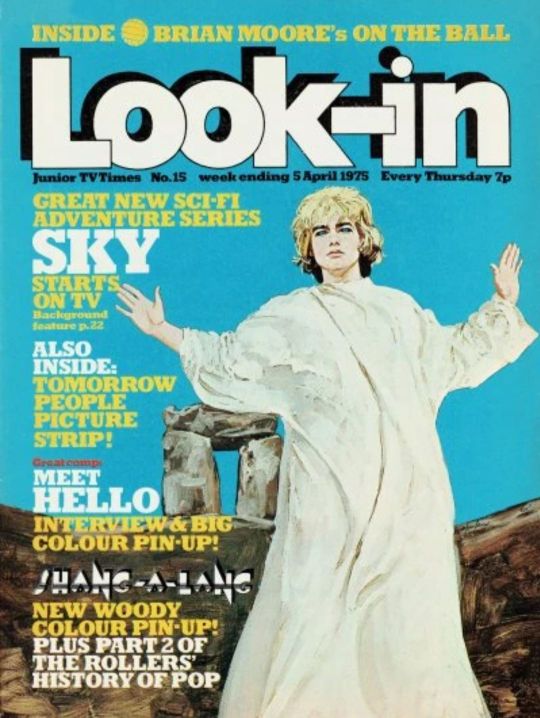
The introduction to this series of posts about 1970s TV series can be found here:
Ever since I first started blogging about TV a decade ago I have been more interested in the effect that blogging would have on me than on an audience, and aimed to make blogging watch TV more thoughtfully. It is very pleasing that nonetheless a number of people kindly read my witterings here, but I am really the ultimate amateur and while I try to keep an eye on what everyone else on the blogosphere is saying and say something different, my blog posts are like thoughts which go out into the net without an intended reaction or audience. Once again the act of blogging has proved its main effect to be on the blogger, because writing these posts about 1970s TV shows has made me think something for the first time.
I often divide 1960s TV into the real and the unreal, and in the past I notice that I have tended to divide 1970s TV into the gritty and the non-gritty. But actually looking through 1970s TV shows to choose ones to blog about has given me a bit more of an overview and I have noticed that it is possible to divide 1970s TV into five categories.
1. Shows which draw on the spirit of the age and so come up with a show which is about adventure (The Protectors), sophistication (Jason King), sex (Man About the House), ordinary life (The Fenn Street Gang, Love Thy Neighbour), and so on. These shows also somehow manage often to be very sexy, very racist, or occasionally very distressing because they depict the 1970s as they really were.
2. Shows which draw on the spirit of the age and instead come up with a show which is about Paganism (Children of the Stones), magic (Ace of Wands), ghosts (The Stone Tape), New Age, environmentalism (Sky), science fiction (Sapphire and Steel), folk horror, or the otherwise strange (The Owl Service) and so on. If I'm forced to place it in one category obviously Survivors would have to go here.
You may say, and you would be right, that the line I am drawing is once again between the real and the unreal, but I think I'm seeing a shift in the reality here. I think in the 1970s *both* of these two categories were real: there was a boom in all things occult, new age, spiritual, etc, and the environmental movement was getting into its stride. I can't overstress the point I am making, that I don't think in the 1970s people would necessarily have seen the second category of show as unreal in any way: the Age of Aquarius had started and all things were possible.
Sky (1975) is one of the more classic examples of shows which walked into this world and essentially exploded.
I am going to have to admit here that doing this series of posts is what has made me watch Sky again and actually pay attention to it. I have had a pirated copy on my hard drive for at least eight years and watched through it when I first got it, but not since. It is about a strange boy who appears on earth with a message for us but who has managed to arrive at the wrong time and the earth's 'immune system' tries to reject him. Of course even if you've never seen it you already know without me telling you that the writers wrote for Doctor Who. I'm not going to focus on a single episode because I don't think I can get a whole blog post out of one.
The show manages to include pretty well everything in my second category above, and I can only say it would be a bit mind-blowing if you weren't expecting it. The boy communicates telepathically, there are mystical and environmental issues, it is filmed in the settings of some of Britain's ancient sites: it's like a experiencing what your neighbour who smoked too much weed in the seventies and wrecked his brain, saw. In fact watching it is a very strange experience indeed. It moves at the pace of a very elderly snail, some seriously weird things happen (I'm not even going to try to describe some of the effects). It looks about as old-fashioned as you can get and yet you just know the events couldn't have happened yet. It's virtually impossible to know what on earth is going on.
This show is genuinely like smoking the seventies. In fact I'm delighted to see on a couple or reviews that I'm not the only one who thinks the drugs probably contributed quite a lot to this show, and in fact it is really quite trippy.
They had the genius idea of including 'kids' rather than characters identified as adults, as a foil to sky. They are exactly like the 'kids' in Scooby Doo, old enough to drive, yet young enough to have the youth and resilience to carry on with the mind-expanding events.
I do have a question about whether something else is referenced, which I haven't seen anyone else ask. Sky is looking for the Juganet, which is what will help him get back into the right time. In 1969 ARPANET, the military/government predecessor of our current intervet, became active and I wonder whether Juganet was intended to sound like it. I have no idea whether ARPANET was actually secret at the time or whether the writers could have been confident enough of geeky enough viewers recognising the reference. Even if it isn't deliberately referencing, the name and idea of the Juganet are strikingly close to the sort of net we are now familiar with.
I think if this kind of weird stuff interests you you should watch this show. If I have any criticism it is that I find it utterly confusing and I do wonder what this show would have been like made as a film by people who weren't stoned.
This blog is mirrored at
culttvblog.tumblr.com/archive (from September 2023) and culttvblog.substack.com (from January 2023 and where you can subscribe by email)
Archives from 2013 to September 2023 may be found at culttvblog.blogspot.com and there is an index to the tags used on the Tumblr version at https://www.tumblr.com/culttvblog/729194158177370112/this-blog
0 notes
Text
ALL THE BOOKS I READ IN 2022
This year I was mostly focused on my career (and I fell in loveeee) so I’ve not had much time for reading. Nonetheless, here are the books I managed to get through. (I'll do another post on the books I bought but haven't finished!)
This has been a bad reading year for me, so I was surprised to see that I read as many as I did. I think the reason for this is that now I have multiple ways to read eg. My kindle, the kindle app on my phone, audible, and hard copies. I bought myself a Kindle last year for Christmas, worried that I wouldn’t ever pick it up, but I use it all the time! (Hasn’t curbed my love for physical books though.)
The Seven Husbands of Evelyn Hugo
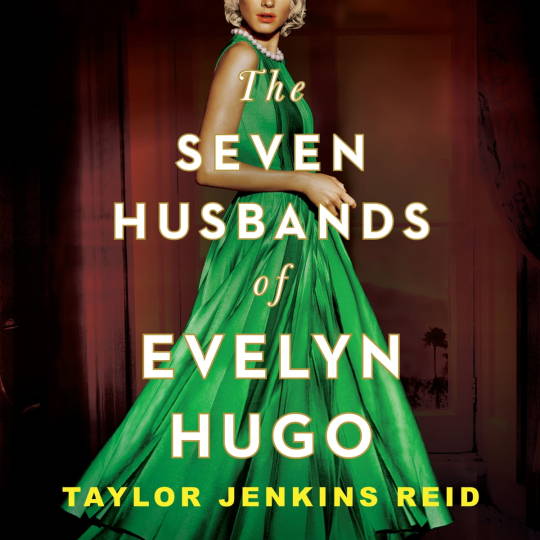
I highly doubt Tumblr needs to be told how great this book is. I loved every second, I cried, I’ll buy whatever the author releases next.
Normal People ✨fastest read!✨
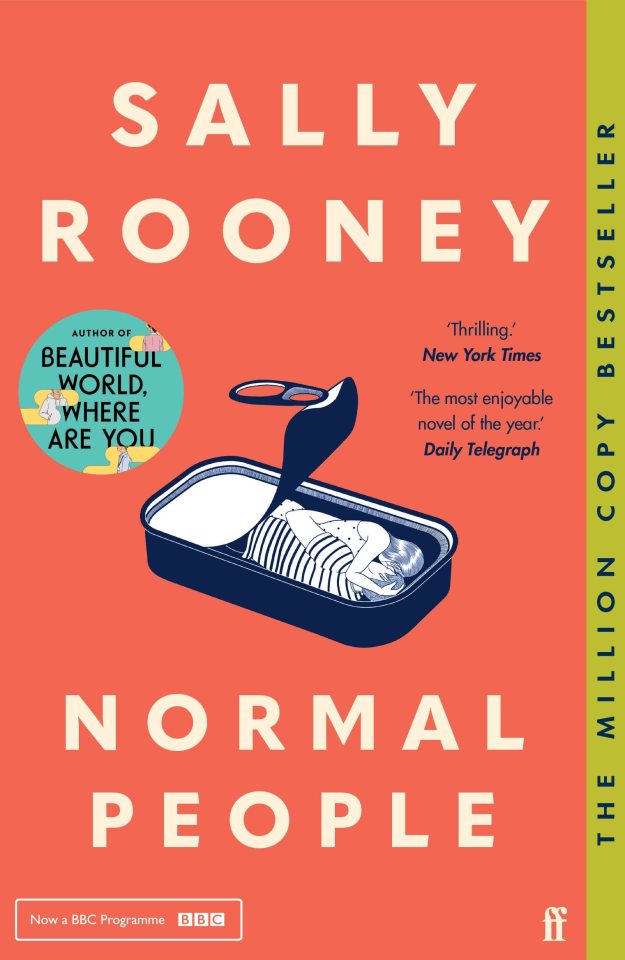
I really needed an easy read after stopping and starting so many books and I just swam right through this one. I finished it. I sulked. I watched the BBC series. I find it hard to recommend because it’s not satisfying but it’s real.
They Both Die At The End

I read the entirety of this book commuting. To and from London, up north and back to Manchester. It was great to dip in and out of. It made time pass by quickly. I cried like a bitch. Highly recommend.
Ark
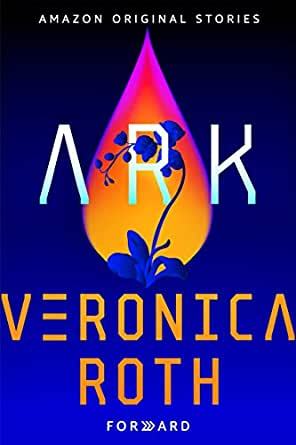
It’s a short story but a lovely one. I was looking for more Veronica Roth books like a hungry dog, this satisfied the itch.
Press Reset
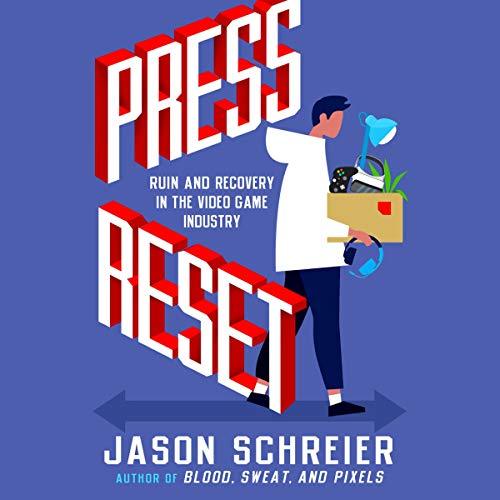
This was work related. It’s a great insight into the video game industry, probably not interesting if you’re not in this field.
Chess ✨new all-time favourite book✨
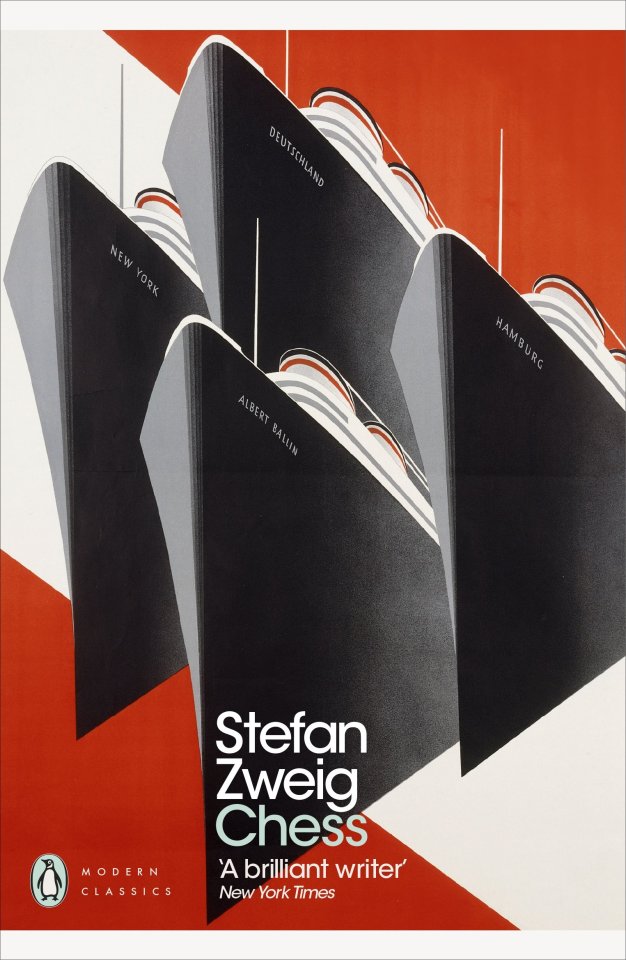
London Euston station bookshop staff I owe you so much!! I was looking for a short read for my long journey back to Manchester. I spotted this short book with a handwritten recommendation. It surprised me. Stefan Zweig is an author I’ve never heard of before. With a book name like “Chess” I expected a strategic story. To me it is colourful, people focused and wonderful. I love how he clearly writes the motivations of characters and how the story seems fantastical but real. I sent my writer friend 7 voice notes about it then bought her a copy of it for her birthday.
Primal Branding
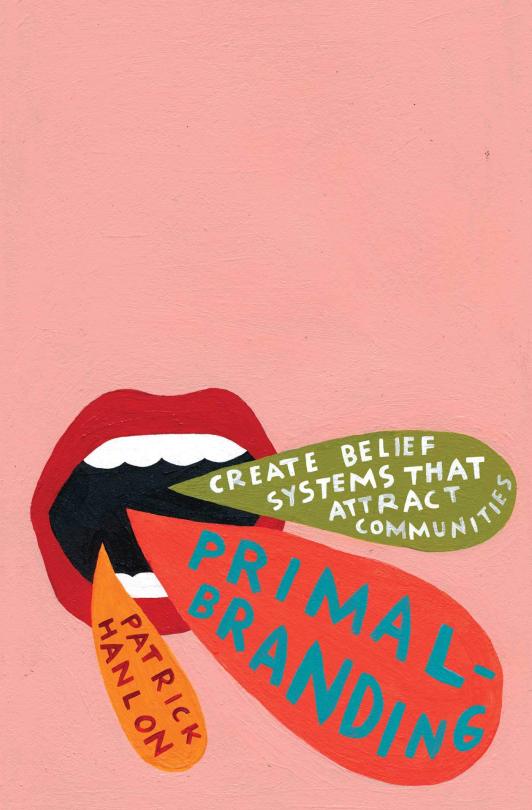
Another work one. Marketing related, interesting case studies, goes on a bit.
Fatal Attraction 😶least favourite😶

My auntie gave me a bunch of books a while back and this thriller caught my eye. Sadly, it had potential to follow through but didn’t.
Whoever Fights Monsters
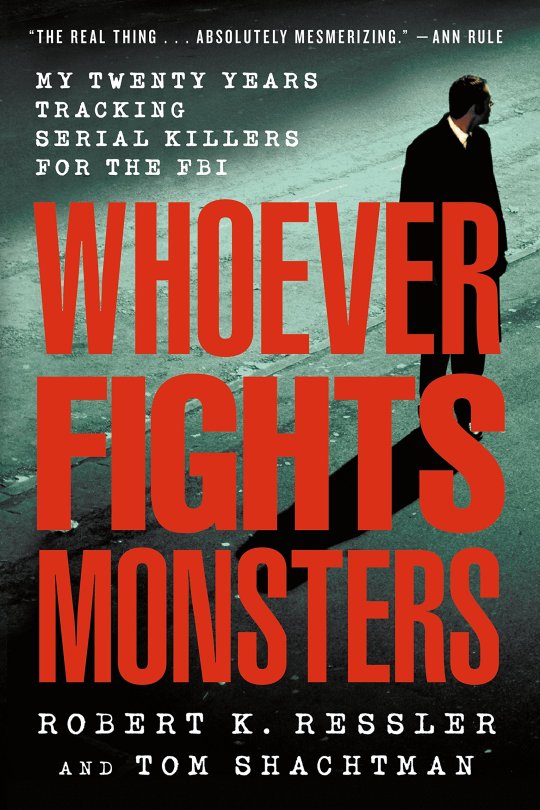
Non-fiction! This book was written by the man who invented the term serial killer. He writes about many cases he helped solve and serial killers he interviewed. It's very interesting, not just the parts about serial killers but his determination. He's worked in some very difficult and slow-moving agencies, yet got through the bureaucracy to get this work done.
The Thursday Murder Club

I really wanted to like it. I really, really, really did. But I didn’t. I couldn’t get attached to the characters and it felt like it was aimed at an older audience that wanted to be seen, which is lovely! But not meant for me.
Poirot’s Finest Cases
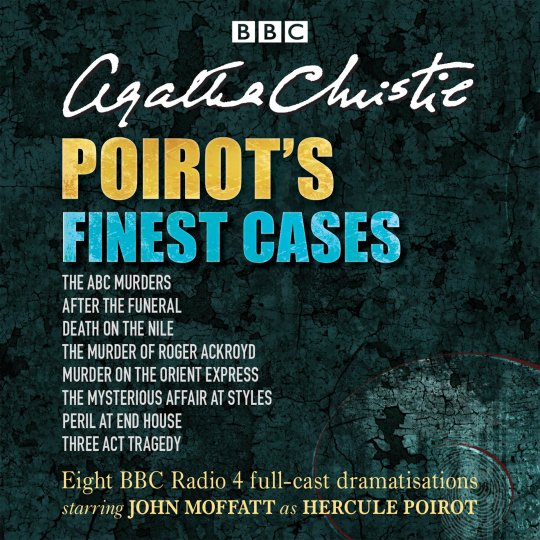
Audiobook. Top lad that Poirot.
Tribe: On Homecoming and Belonging
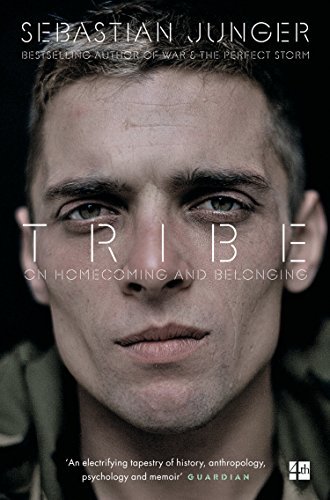
Work related read. I wrote a blog post about it on my work website here. https://www.charisreid.co.uk/blog/charisreidstribe
Project Hail Mary ✨recommend the most✨
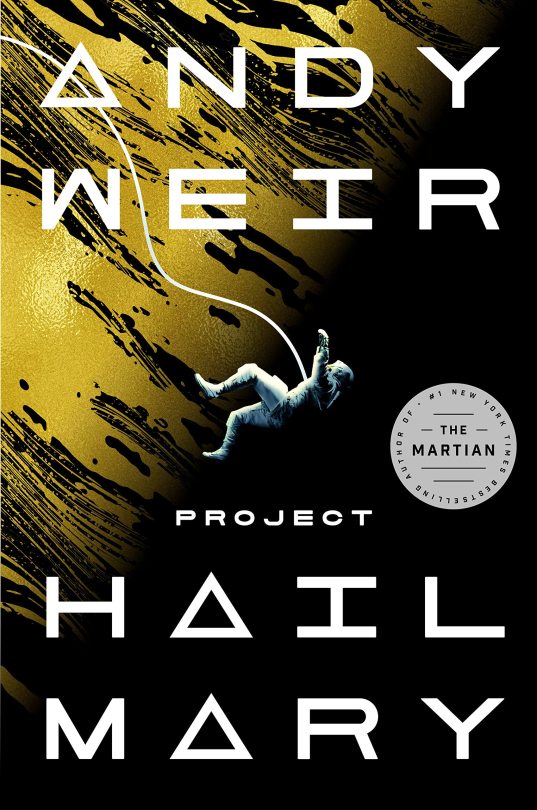
A friend recommended me this and I loved it. It’s only available on audible right now but I really recommend it. It’s fun, heartwarming and I love how the problems the character faces are all science-based. Really rad. 10/10.
(I also reread the Hunger Games trilogy bc it’s my comfort series, so let’s include that)
✨16 total books finished in 2022✨
I'll do another post about aims for next year and what I'll be starting to read in January!
#read in 2022#book recommendations#booklr#books#now reading#2022 books#to read#book list#book worm#book addict#project mary#hercule poirot#they both die at the end#the seven husbands of evelyn hugo#normal people#whoever fights monsters
10 notes
·
View notes
Text
Steven Universe: End of an Era: Outline & Review
I wrote this review in October but never got around to posting it here
Steven Universe: End of an Era is far more than an art book–it’s also a collection of behind-the-scenes material, stories about the experience of working on the show, planning documents and associated background info, and both older versions of developed concepts AND concepts that never made it into the show. It's a huge fusion of all those elements, and it's definitely an experience!
Some low-quality images are included with my review just to give you an idea of what’s there--it’s not a good substitute for getting your own copy, but here’s a tour!

Like the previous concept art book, Art and Origins, I'll be giving you a description of the structure and overview, while also collecting notable information for fans. Obviously just about everything is "notable" once again, but I'll aim for unique insight or perspective on the main source material, keeping the screaming about everything new to a minimum so you can also enjoy something for yourself if you pick it up. My low-quality photos should prevent people from feeling like I'm reproducing the book in any capacity. Please grab one while you can and have your own experience!
[SU Book and Comic Reviews]
OVERVIEW
The book is titled "End of an Era" for a couple reasons--obviously because it is released after the show has wrapped, but also because Gem history recently ended its "Era 2" and began Era 3--an age of prosperity and peace. The author--the person in charge of adapting all of this information into this slick, readable package--is Chris McDonnell, whose work was previously applied on the Art and Origins book.
The foreword is by N.K. Jemisin, a well-known science fiction author who's a huge fan of the show (and wrote a really excellent series that also has a weird geological connection, by the way).
And the cover, like its predecessor, is shiny and decorated with a beach scene featuring minimalistic characters--this time it's the Gems at night in front of the Temple, and on the back cover is a big pink leg ship in a cross-legged pose.
The interior covers are decorated with tons of amazing sketches of Steven and Connie on the front, and a bunch of Gem sketches on the back. Every interior page that most would leave blank is highlighted with some kind of sketch art or character exercise--it's so much to look at, so much to absorb.
The book is dedicated "For Eddie."
Its organization is different from the previous book in that it shares applicable work in chunks associated with groups of episodes rather than pertaining to different aspects of building the show.
FOREWORD

N.K. Jemisin gives us such a great introduction to the book--apparently understanding very well that the audience of this book is full of animation enthusiasts and adult fans more than it is full of kids, and explaining that bewildering journey some adults had from blowing this show off as a silly kid thing to falling in love with it hard and fast.
The important thing, Jemisin says, is being able to trust a storyteller with your heart. And it was clear to her that Rebecca Sugar knew what she was talking about and was saying important things about identity and the radical power that comes with accepting it and demanding respect.
Important also is how we handle heroes and who gets to be one in fantasy. That's part of the reason Steven Universe speaks to so many--because we see ourselves here, and know stories can be about us. Acknowledging the power we all have to MAKE THINGS BETTER with what we fight for is so important--especially if we're going to speaking to the next generation about it.
Highlighting Rose Quartz as a "born leader" who failed and Steven as a relatable scamp who did what she couldn't, Jemisin asserts that we can save the world.
1. END OF AN ERA
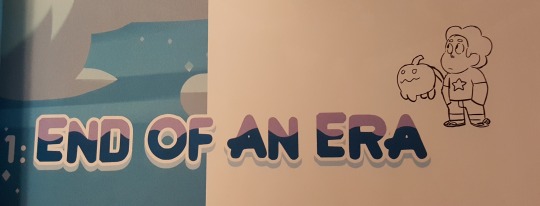
We start with an appeal to the audience to think about identity and the formative parts of our childhood--and how different it is if who you are and who you become is restricted, mocked, erased, or Not Allowed. Most people, if not ALL people, can relate to this, but for those of us with a special relationship with Steven Universe because of queer identity, this hits hard.
But it doesn't have to be anything grand to be something we respect--this show's authenticity comes largely from how personal everything is, drawn from real-life experiences and incidental truths from each artist's perspective, leaning hard on childhood and formative experiences.
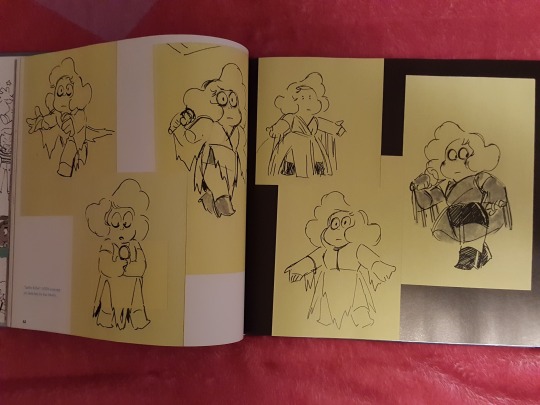
Rebecca Sugar offers some interview bits to discuss writing philosophy and why "writing female characters" was difficult for a nonbinary person who'd been socialized as a girl and a woman. Rebecca has spoken before about how frustrating it is that marketing for cartoons was SO gendered when she was growing up (and to some extent still is).
The Gems in the story are all "she/her," but on their planet they're defined by their work, not by emotion or relationships (unlike women in our society), so having them be socialized opposite to how she was and be able to claim those emotions through choice and NOT as just an expectation "as women" was revolutionary. Rebecca wants her show to tell all marginalized people that they don't deserve to be in the margins.
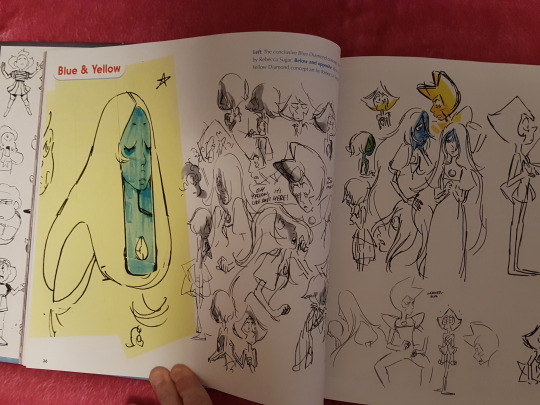
Weighing in on other aspects of the show were Ian Jones-Quartey, Joe Johnston, and Miki Brewster. Ian describes feeling like at first doing SU was a thrill ride that meant they'd finally get to do all the cool stuff, but it quickly became a responsibility that he took very seriously--the need to tell a good story now that he'd been given a megaphone.
Promotional art, planning documents, character sketches, and concept art from the lighthearted to the stone serious is included, along with some very cool (sort of famous) timeline charts that track major characters' developments. It's emphasized by Rebecca that the developmental materials ARE NOT CANON (and especially are not MORE canon) compared the final show.
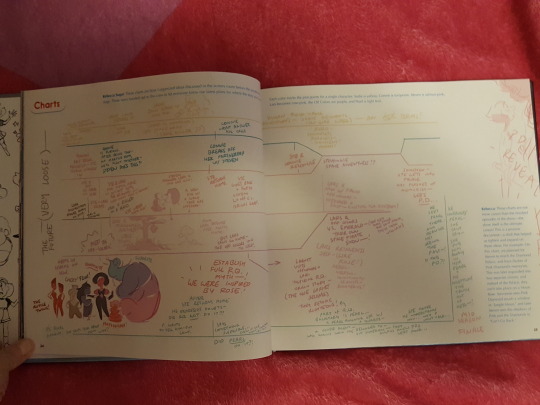
There are concept sketches alongside final art for Aquamarine and Topaz in "Wanted" (with Topaz labeled "Imperial Topaz"), the Zircons in "The Trial," Blue and Yellow Diamond, and the Off Colors (including Pink Lars).

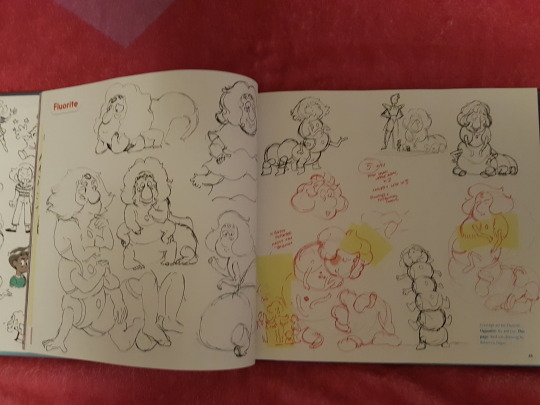
And there's also a spread of "the two sides of Steven's life: Gem Magic and Rock N Roll" featuring Sadie Killer and the Suspects (referred to as "Buck's band")--as well as a cool "Crew Cameos" key and some concepts for short-haired Connie.
And then there's some more "finished" art with stills alongside concepts, including some background art, revision, and really cool "fairytale" art from some of the shadowplay storytelling bits. We get "Lars of the Stars," "Jungle Moon," and "Can't Go Back."
2. THE BEGINNING OF THE END: A SINGLE PALE ROSE

In discussing the huge reveals and Gem mysteries in the show, the pacing is examined, and emphasis is put on the intended "slow burn." One of the most difficult things in the show was to strategize so that every piece that was needed to support another piece in the future was placed properly to seed what it was supposed to.
Some of the ideas they developed were more of a group effort and were fit together collaboratively (like Amethyst's being younger than the other Gems and Jasper being from Earth), while others were intended from the beginning based on Rebecca's vision (the fundamental idea of Pink Diamond's true identity, for instance, as well as Obsidian's design and sword and our Pearl not being Pink's first).
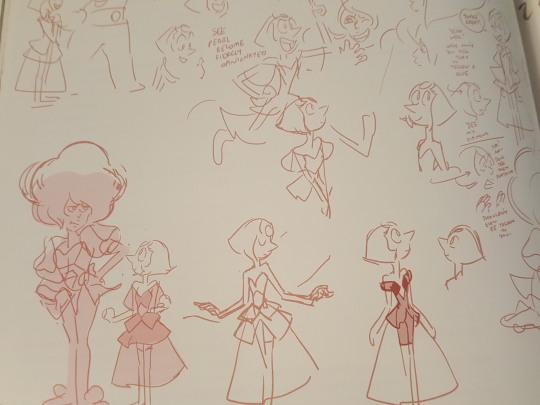
The writing process gets a great deep dive here, including fun tidbits like how the orb in the moon base was inserted by Joe Johnston and they literally had no idea what it was for when they wrote the episode. They repurposed it when they figured out what they needed.
Rebecca credits her detailed timelines for helping keep the order straight, and discusses how other artists are sometimes flabbergasted that a storyboard-driven show can have this much detail and continuity and yet not get wrecked by the free non-scripted boarding process. But Rebecca and the Crew valued that approach and loved the way fresh eyes would handle an idea, making it come back alive, entertaining, vivid.
Several Crew members weigh in on the writing process. Lauren Hecht refers to making lots of incorrect guesses despite being on the inside. Joe Johnston recalled getting briefed on his first day and getting so excited to start working on this massive project.
Miki Brewster remembered being told Rose Quartz is Pink Diamond and being shocked--and also confused about why Ruby and Sapphire would need to be married if they're already basically married. Drew Green talks about being brought in late and getting to watch unaired episodes and a rough of the movie while eating cereal.
Ian Jones-Quartey complains about Pink Diamond's real jester-like form being leaked to the internet through a Hot Topic shirt. Rebecca piggybacks on that and says it was upsetting that the wedding was leaked because of toy fair keychains featuring Ruby and Sapphire in wedding attire. They'd always be worried about leaks, and sometimes Rebecca struggled not to talk about the reality of Pink Diamond before the reveal because she knew it would make so much more sense once the truth was out. And everything associated with Rose makes more sense once you know she's Pink--especially what happened with Bismuth, considering what we know about how Pink Diamond has a habit of treating anyone who no longer serves her interests.
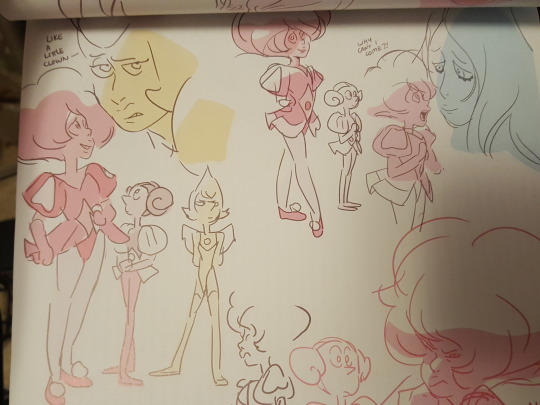
When it comes to visual cues, Rebecca also talks about intentional designs to create a feeling of unity between concepts, like the flower shapes on Pink Diamond's palanquin lining up with the poofs of Steven's hair and the star imagery of the series. Steven Sugar and Mary Nash discuss how the Human Zoo incorporated this imagery, trying to look like Homeworld with a Pink Diamond touch.
Steven Sugar, as a game nerd, liked to throw in video game references from old and modern stuff to feel like he's inserting what he's enjoying and who he is from moment to moment, while Mary Nash, who related to Sadie as a basement-dwelling young person with cult interests, liked to include stuff from MST3K and cult movies. Pearl's hand gestures get a spotlight too--her reflex to cover her mouth when Pink Diamond was being discussed was analyzed here.
A "Top Secret Visual Timeline" from 2016 is included which tells us some Diamond history. It has an earlier version of Pink Pearl's fate and does not include Spinel since the movie hadn't been greenlit. The timeline includes the birth of the Diamonds, the emergence and major story beats for each major character, and some philosophy of the driving force behind each.

We're told that Pink Diamond straightened up, behavior-wise, after she lost her first Pearl, and that Yellow and Blue wanted to give her a planet but White only agreed to it to prove she would fail at managing a colony. Pearl, meanwhile, is so confused to have a Diamond who keeps asking her what she thinks when she doesn't believe she should have opinions.
And when Pink moonlighted as Rose to start conflict, she found herself leading an army to fight Pink's troops--then Yellow's, and eventually Blue's too. Lapis is said to be waiting for the conflict to end on Earth so she can terraform, but she gets trapped instead.
Pearl's love story with Rose is described as "an endless honeymoon" where she's free to love her, while Rose's is more like "I'm now the head of the family and I'm going to give everyone what they never had, so everyone is super special!"
Jasper is described as "adopted" into Yellow's army as the only successful Beta Quartz. And White Diamond knew that Pink Diamond was not dead--she thought she was just running away from home like a brat and would eventually be back.
3. THE HEART OF THE CRYSTAL GEMS

Now we discuss Rose Quartz--the original Pink Diamond. How she was selfish and selfless, never enough and always too much, and how Greg was her first partner who "challenged her" to be an equal. Rebecca describes Rose as being delighted by the idea that both she and Greg reinvented themselves, but when that leads her to want to share her past, Greg isn't interested--he only wants to know who she is now, and doesn't consider the old her to be her.
Rebecca likes Carl Jung's concept of "enantiodromia," which is the idea that extremes lead to their extreme opposite. This is demonstrated in all of the Diamonds. This narrative is interspersed with drawings of Greg and Rose being cute.
But another "heart" of the Crystal Gems is its relationships--particularly, Garnet, the fairy tale romance embodied. More psychological theories are discussed with regard to differentiation in a relationship making the relationship stronger, and how they made sure that happened for Garnet during the appropriate arc. Rebecca has struggled with the idea that she, like Ruby, went straight from a "family" group to a living-with-others situation and never lived by herself. But she also learned that you can in fact develop as a person in the context of a relationship--you don't have to be alone to do it. Ruby learned that too, and chose on her own terms to be with Sapphire.

The wedding made so much sense to Rebecca and the crew that they couldn't imagine a wholesome couple like Ruby and Sapphire not having a wedding episode. They wanted it for years: The wedding concepts always included the tuxedo for Sapphire and the wedding dress for Ruby.

But pushback (often blamed on the conservative standards of the international market) led to negotiations trying to keep Ruby and Sapphire's relationship from being explicit. Rebecca and the Crew were very tired of this double standard, and they were especially irritated by attempts to claim a wedding wouldn't be well received by a core demographic or wouldn't make sense for Steven's character. But other shows had done weddings and Steven had been established to love weddings already.
Rebecca kept adding more elements to the wedding episode to answer all the concerns, but she didn't want to back down from explicit marriage between these characters. They deserved it. And the audience deserved to see this as wholesome, like any other cartoon wedding. Eventually they got their way and were allowed to have the wedding. But the ordered episodes were also coming to a close without promise of more, so Rebecca had to request more episodes to be able to wrap up the storyline!
And of course, there is Steven, the true heart of the team. A very interesting aside discusses Garnet's leadership and how the network pushed the Crewniverse to acknowledge Steven as the leader. This was successfully resisted throughout as well--because Garnet is the leader (unless she's incapacitated, of course). It's fantastic that this concept was preserved because too often a young male chosen one is elevated above people with more experience and knowledge because of that chosen one tradition, so it's really nice to have a show acknowledge that team leadership is more appropriate for an adult.
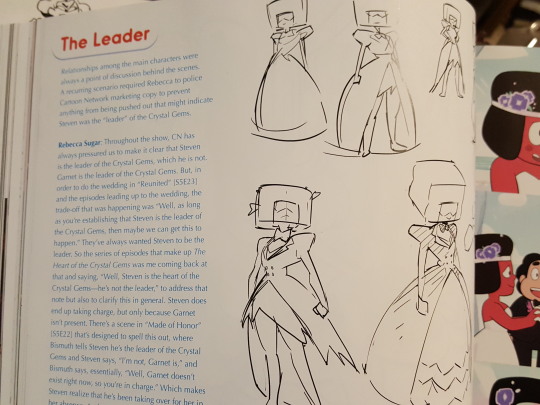
4. ERA 3

Beginning with a discussion of the Diamonds, this chapter deconstructs the dysfunctional "family" of the Diamonds (who are said to be based on tropes about evil stepmothers and stepsisters), with the thread of dysfunction originating with White Diamond.
Yellow is physical, Blue is emotional, White is judgmental, and Pink is impulsive. Some philosophy on why Pink is naturally manipulative and why she clashes so much with White is offered.
White believes her identity is to be imposed on all because she is the pinnacle of what should be--and therefore, she has the right to make decisions and statements about and on behalf of everyone. But her secret is that she can't do what the others do--act or feel or want. In trying to be everyone, she is no one.
And this becomes very important when she confronts Steven about his identity and turns out to be wrong. The triumph of Steven being totally, fully himself is a beautiful, simple revelation that's described as far more satisfying than the theories about Pink living inside him or Rose returning from his Gem.
Also discussed is Gem architecture. A lot went into this idea, and Steven Sugar weighs in to say he had to think of what it would mean for a world to have buildings but serve no human needs. That's why it's mostly focused on transport and storage. Even the broken planet is meant to indicate a place stripped for its resources, and everything serves a function that is meant to avoid looking like the human equivalents.
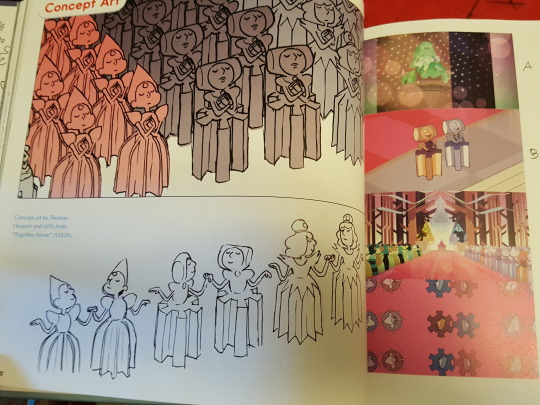
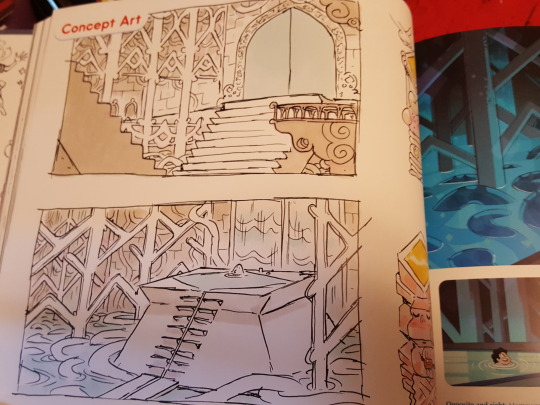
And there's another layer, too: a difference between Era 1 and Era 2. Era 2 became more functional to hide Era 1's broken bits, and older Homeworld buildings still have some "ornate and ancient" feel to them. And the fact that props, tools, and even walls and doors could be living was taken from a concept Rebecca thought was horrible from old Busby Berkeley movies, where people were inanimate objects and it was portrayed as lovely. Tom Herpich helped conceptualize these living objects.
Steven dealing with "princess tropes" is discussed here too. The Pebbles (worked on with Pendleton Ward) were sort of his Cinderella's mice, and all the locked-in-a-tower, having supportive tiny friends help you, getting princess clothes made, attending a ball, having to mind your manners stuff was intentionally related to fairy tales.
The point of doing that (besides fun) was to easily invoke the feeling that Steven was being made to be someone he's not, and that he was being treated like THIS is who he really is when it isn't. White Diamond as the "evil stepmother" is discussed with regard to her detailed features and massive scale. They generally didn't put fingernails and eyelashes on characters (especially not to indicate that they were women or girls!), but they decided White would get all of these feminine markers for tradition's sake.

Rebecca also invokes several other references that were included and describes the princess tropes as "chipping away at his integrity" setting him up for the final challenge with White.
There is again tons of concept art: Homeworld architecture, Pebbles, Diamond diagrams, background Jades and Lemon Jade Fusion, Comby, Diamond extraction chambers, and White Diamond.

5. CHANGE YOUR MIND

Now we finally begin to discuss Steven's identity. The "Perfect Steven," discussed in several interviews before this book's release, was an idea back in 2013; the "ultimate Steven," beefed up and shonen-looking, was far from perfect because OUR Steven is perfect, while this alpha hero Steven idea (used in Steven Universe Future) didn't belong being idolized in such a show.
They thought about having Steven fall apart into organic half and Gem half early in the show (during "Giant Woman" after a successful fusion and unfusion, even!), but they didn't try the concept until the last episode. They didn't want the "Pink" Steven to be portrayed as "better" even though he would be more powerful, so they decided he isn't whole without his organic self and he's just as much of a shell as the organic half. They absolutely did not want any ending that required Rose to be inside him or waiting to come back. But the debates were fierce--what DOES it mean to have Rose's Gem?
Ian Jones-Quartey brings in an anecdote about his own family to emphasize some of the immigrant themes that inspired aspects of the show. He had a brother who reinvented himself elsewhere away from family without resolving issues, and all the ramifications of that were explored in the show through Rose Quartz. (He is careful to say he doesn't think his immigrant experience is like being from another planet!) But he did say you can hurt your old family even if they were toxic or didn't know the real you, and you can hurt your new family by hiding your past. The Pizza family of course was also a more direct reference to Ian's Ghanaian family.
In talking about the new Fusions from this episode, Sunstone is largely described by Miki, who also got to board the Sunstone section. Sunstone was described as a cool 1990s character and the evolution just continued into making them a fourth-wall-breaking PSA dispenser. Obsidian is also discussed, with their sword being an early concept. Steven Sugar said they totally knew it would be forged in action. Obsidian being similar to the Temple design is of course another very early detail.

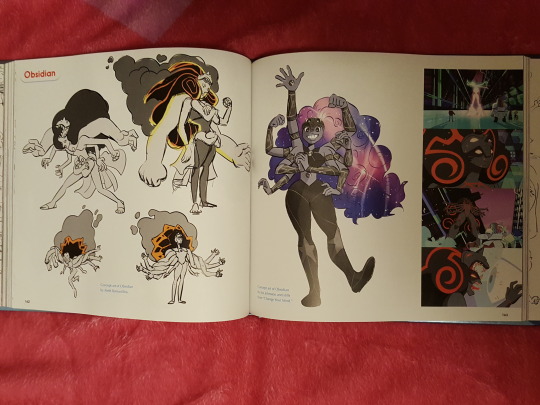
The story of how James Baxter got involved with one of the final scenes (Organic Steven and Pink Steven fusing in front of White Diamond) was shared. His family was fans of the show and Rebecca Sugar took the time to drive to a birthday party for his daughter and give her a drawing. He then owed her a favor, and this was it.

Concept art is again included, this time with sample boards, promo images, a Diamond fight concept, costume design changes for the Gems, new Fusions, the so-called "Mega Diamond" ship conglomerate, some scenes from the White Diamond confrontation, Pink Steven, multiple pages of James Baxter animation, corrupted Gems and their healed selves, and photos from the "Change Your Mind" premiere and some awards. The show has won one design-related Emmy, a Peabody Award, and a GLAAD award.
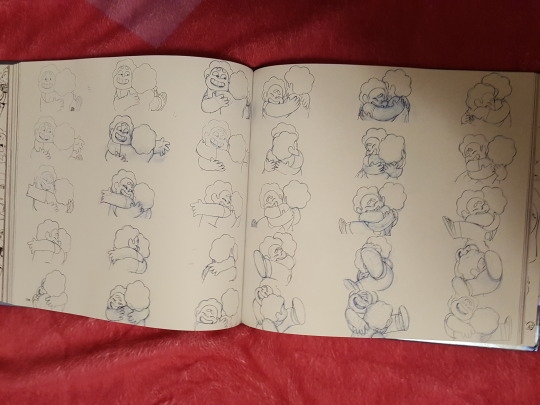
6. STEVEN UNIVERSE FUTURE

The book doesn't cover the movie because it got its own book, but dives right into Future. Ian Jones-Quartey emphasizes that the movie and Future are separate and different from the original show, which ENDED. After all, after that, Steven has a neck!
Some new names are invoked now: new writers Kate Tsang, Jack Pendarvis, and Taneka Stotts. They were excited to have Steven make HIS OWN mistakes instead of trying to clean up someone else's! Now, instead of doing the usual shonen anime thing and having the final battle be a big physical rumble, Steven has to make peace with himself and take an active role in coping with what all the fighting has done to him and what effect it's had on who he is (and who he wants to be). There is no sudden "I love myself!" answer, either. It's always a process.
Drew Green and Maya Petersen, who came on board as storyboarders officially in Future, also weighed in on writing for a "mature" show, how to deal with Steven being a "moral compass" while being sort of unreliable, and what they learned as Crew that they didn't know as fans. Drew didn't know Garnet never asks questions. Jack didn't realize the show never deviated from Steven's point of view. Taneka was nervous but excited to collaborate. Kate was worried about how established the show was and what to do as a new writer to contribute appropriately.
Maya was on the old Crew but not as a storyboarder, so felt like some of the "old" ideas ended up not being appropriate for the "new" Future in an embarrassing way--and dreaded the idea of dealing with Steven's emotional problems when they were similar to stuff she'd been through. She also was personally behind the idea of Steven wanting to dump his problems by becoming Stevonnie, and got to work with Etienne Guignard on inventing the Pearl creation backstory with Volleyball.
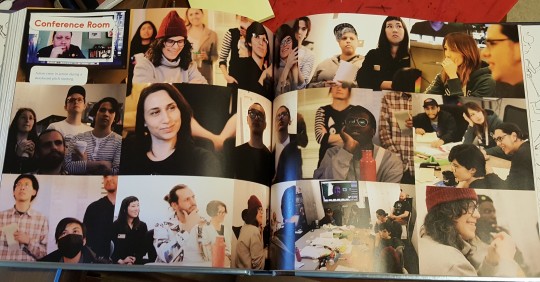
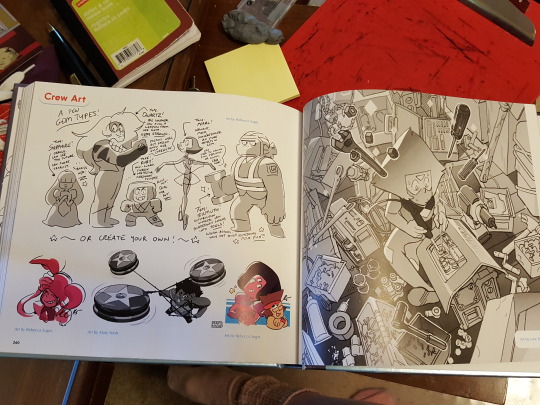
There's some discussion of "depression hobbies," stress, and the show's pacing. And they say Etienne was entertaining at pitches. There's even some discussion of how Greg is taken off a bit of a pedestal because his terrible restrictive life in the suburbs sounded wholesome to Steven and Greg presented it negatively.
And then there is some information about how the Crew felt behind the scenes due to fan reactions and negative press. Ian discusses feeling offended when the Black characters are described as bad examples, as if their cartoonized but realistic-in-context features are automatically caricatures.
Rebecca Sugar felt beaten down by some of these narratives and began to access mental health services, inspiring some of the content of "Mindful Education." A long reflection from Rebecca discusses people's infighting about her show and what she had a responsibility to show or not show in the story. She learned a lot about bullying from Cartoon Network's anti-bullying program and learned that bullies thrive on whatever attention you give them--unless it is made clear to them by a peer group that no one is impressed by their cruel actions. Also, not all negative feedback is bullying. Constructive criticism is different. Self-awareness can help you avoid internalizing what bullies might do or say to you.
Segueing from the discussion of how people are affected by and connect with the show, we then discuss how they chose as a team what should be covered as the show came to a close. They didn't have time to do quite a few stories they wanted time for, like a Rhodonite story, a Lars side story, and Diamond "prehistory" and religion; all of it was put aside for the main arc with Steven.
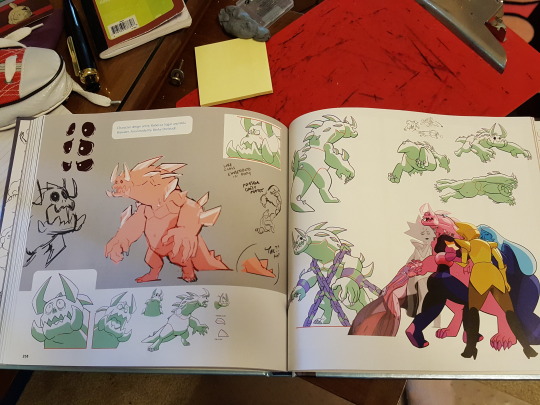
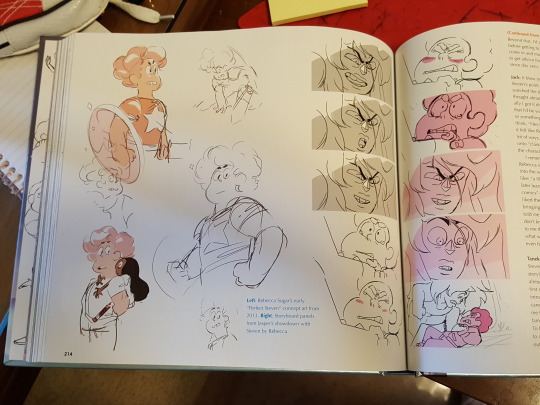
They thought people would find those stories about Homeworld and Off Color history very interesting, but so much of the show had been about Steven's Gem adventures, so keeping him mostly on Earth seemed appropriate. The acknowledgment of his battle damage, of his trauma, was necessary and real, and helpful in an important way to the core audience.
Oh, and there was some stuff about a cheeseburger tree. Don't ask.
In discussing the "reverse escapism" of the original show (Gem aliens are intrigued by everyday human culture, and realism is necessary), Rebecca says her views have changed on escapism and gets why some people want a soothing feel-better show. She acknowledged also that her own escapist dreams-come-true fulfilled in the show didn't feel like escapism because they were givens to the majority of mainstream culture, but were never guaranteed to marginalized people.
Rebecca ties in her several-times-told story about "Love Like You" and how the middle bit was when she didn't feel she was worth looking up to, and the realizations she had to tie the beginning to the end. Feeling like someone will like you less if they know you more is terrible. So sometimes a show like this can be helpful in telling people that they belong when their fantasies are things like "I want to be loved" and "I want to know I exist."
In Future, Steven has to connect to who he is and love that person--and understand that person enough to finally feel that even if he's not fixing their problems or saving their world right this second, Steven deserves his family's love and support, and they WANT to give it to him.
There's a huge amount of supplemental material in this section so there's no way I could name it all. The charts for Future's timeline are pretty straightforward, though a few episodes like "A Very Special Episode," "Why So Blue," "In Dreams," and "Bismuth Casual" aren't specifically represented and a couple are in a different order ("Prickly Pair" was conceived as happening after "Fragments" and "Homeworld Bound").
Steven feeling like a monster, having intrusive thoughts, having not forgiven the Diamonds, and getting help/moving on--it's all there.

We have keys, color scripts, and boards for the new opening and some various backgrounds and storyboard art from episodes. Model sheets for Shep, Nice Lapis and Mean Lapis, Jasper, Steven Tag Gems, Pink Steven Powers, Monster Steven. New house concepts, Era 3 Homeworld concept art for the Diamond environments, and background art for the Reef.
New Connie and Greg designs. Concepts for Mega Pearl, the Rose Quartzes, Bluebird, and Morganite (who didn't get used). And there are some photos from recording and the conference room. There are even some extras from "Crossover Nexus," the crossover with OK K.O.!--including an unused cut scene that included Ruby and Sapphire fighting. The rest of the book is a bunch of adorable Crewniverse art--extras, blog drawings, promos, and gifts to each other.
NOTABLE
1.
The first timeline chart in the book features a cool sketch of the original Off Colors, which at the time this planning document was drafted included unused Off Colors Flint and Chert.
We knew of their existence already because of an episode of the podcast, but these two unexpectedly appeared as incidental characters in the Steven Universe Future episode "Homeworld Bound," identified only in the credits. Sad to think that instead of banding with the Off Colors, these two were probably shattered for their crime (being Quartzes who don't want to fight) and that's why we see them being repaired in this episode. Later, there's some brainstorming for types of Off Colors and "a Ruby that wants to wear limb enhancers" is mentioned as well.
2.
It looks like there was also originally more juice to the story of tracking down the events of the war culminating in Pink Diamond's assassination.
One of the timelines talks about Steven thinking it makes sense that Pearl can't talk about her involvement because she might have been a double agent, explaining why Rose Quartz always knew what Pink Diamond was doing. It seems like that bit was supposed to be included in Garnet's version of the story she believed in "Your Mother and Mine." Seems like they originally conceived Garnet's story to inspire the Off Colors to become pirates and freedom fighters, though in the show's canon this storytelling happened after Lars had already reinvented himself the way he did.
Sadie was also supposed to be sending letters to Lars via Steven, which is funny since the "Letters to Lars" episode is just a montage Steven letter. And of course it's specified that Steven was supposed to get Pink Diamond flashbacks by going to the Palace on Homeworld.
3.
The second chart in the book makes references to Sadie's reinvention of herself as a parallel to Lars, Greg, and Pink Diamond all doing the same thing, and how positive it is to embrace such a thing--a version of yourself that YOU create.
I love that Yellow Diamond's arm ship arm-wrestling the Cluster was always part of the plan.
There's some more explicit direction to have Connie help Steven understand the Diamonds as "strict parents," and a lot more emphasis on everyone realizing Rose had been inspired by THEM rather than them all following her.
White Diamond is presented here as if she thinks of Pink Diamond as a "daughter" (whom she now understands she has "lost"). There are notes on how the Diamonds have a responsibility to their children and should attend to it before just continuing to make more.
4.
One of the concept art images for the Off Colors features Rhodonite crouching by Padparadscha saying "Don't worry, I won't let them hurt you." It's very interesting because she DOES seem to protect Padparadscha in the show, but doesn't seem confident about it in her final version, even though it does seem like she'd be "programmed" to guard aristocratic Gems because of her Ruby and Pearl makeup. Cool.
5.
A "Crew Cameos" spread was included, which is of great interest to some of us who loved seeing the Crew insert themselves into the show. Not every SU Crew person who's been represented in a crowd was there, but this crowd included Amish Kumar, Kat Morris, Amanda Winterstein, Angie Wang, Lamar Abrams, Emily Walus, Mary Nash, Joe Johnston, Christy Cohen, Danny Cragg, Hilary Florido, Danny Hynes, Matt Burnett, Ben Levin, Elle Michalka.
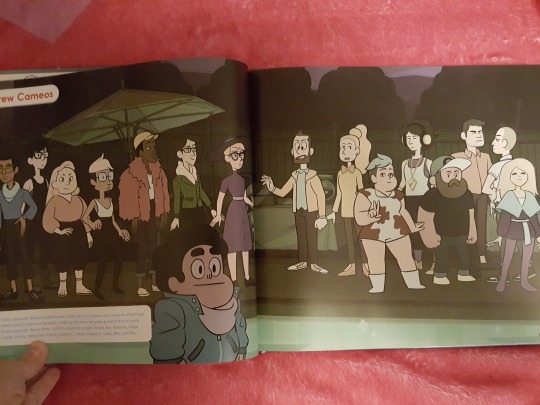
6.
The official national flower of South Korea, Hibiscus syriacus, is the name of Pink Diamond's flower.
7.
One of Steven Sugar's comments about the silhouette difference between humans and Gems points out that humans have ears. This seems to be pretty good confirmation that they are not supposed to have ears, despite that sometimes we'll see ears drawn on them in some frames.
8.
Rose Quartz/Pink Diamond is characterized in this book as "self-hating" in a really interesting way, saying that because she believed she was not capable of compassion, she practically worshiped those who demonstrated that ability and thought they were so much better than her--which is described as "intoxicating" and resulted in others being drawn to her. How interesting is that!
9.
Timelines reveal that early plans for Pink Diamond's first Pearl originally had her getting destroyed by Pink during a game, and then her destruction was rewritten as a punishment from the Diamonds after Pink Pearl defended Pink Diamond to the other Diamonds. They went back to the idea of her getting hurt by Pink for the final version, though the cracked face and control by White Diamond was not on the agenda until they started writing "Change Your Mind."
10.
The approximate ages of the major characters, based on emergence, are revealed on these timelines. It begins with a cracked-planet-looking graphic depicting four tiny Diamonds emerging at 20,000 years ago. Some suspicious "blacked out" redacting surrounds a long timeline tail that goes back before that, which may mean there are secrets they still don't want to reveal. But the dates go like this:
20,000 years ago: The Diamonds emerge.
11,000 years ago: Pearl is custom-made for Pink Diamond.
8,000 years ago: Sapphire emerges (on Homeworld).
6,000 years ago: Ruby emerges (on a colony).
5,750 years ago: Garnet is formed.
5,600 years ago: Lapis is poofed and put in the mirror.
5,200 years ago: Jasper emerges (on Earth).
5,050 years ago: The Cluster is planted.
5,000 years ago: Amethyst emerges (on Earth).
4,500 years ago: The Crystal Gems found Amethyst.
3,000 years ago: Peridot emerges (on Homeworld).
40 years ago: Pearl found Lapis's mirror at the Galaxy Warp.
And of course we know 14 years ago Steven is born!
11.
Originally the Diamonds were based on a quartet of themes: Love, Fear, Pride, and Sorrow. It got too complicated to keep and it was abandoned, with Pink's identification of "love" being described as "particularly outdated."
12.
Notes on a sketch say that Pearl was inspired to become bold and unashamed because Pink's questions drove her to have opinions, and it's said that Rose "fell in love" with her boldness.
13.
Rebecca tells the story of driving off a ridge and getting stuck in the desert, comparing this to Ruby's tumble during her Wild West adventure and using it as inspiration. She's told this story before but here it is in print. She also included the story about using the flowers from a friend's wedding to put in Ruby's hair.
14.
Rebecca describes having to "fight" notes she was given when it had to do with Ruby and Sapphire's relationship. One she describes as NOT fighting was for a signing card depicting Ruby and Sapphire dancing. It was called "too romantic" and she decided not to worry about it since it wasn't the actual show content.
She was also scolded over her book The Answer because the powers that be expected her to downplay that relationship. She always argued that queer youth deserved these things.
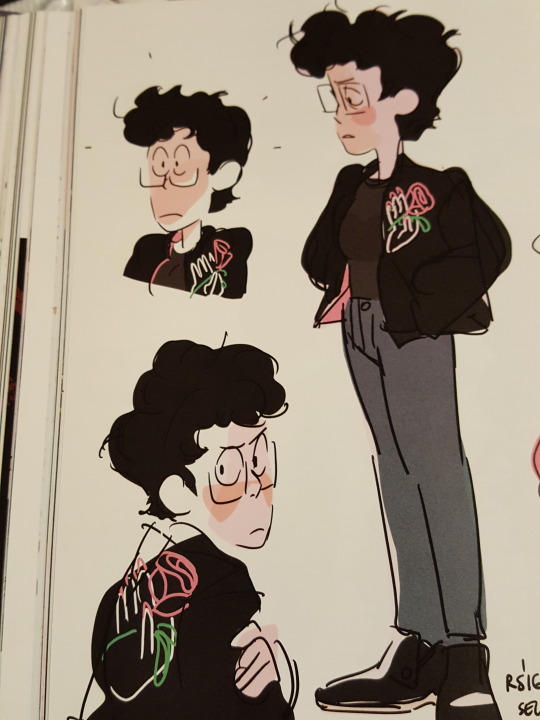
15.
Tom Herpich describes being inspired to name Blue Diamond's comb "Comby" because he was watching the news about Comey getting fired from the FBI. It's also a mineral-related term and I always assumed that reference was intentional, but maybe it's not and this is the only intended significance to Comby's name?
16.
Rainbow Quartz 2.0's design is not discussed, though the other two new Fusions from "Change Your Mind" (Sunstone and Obsidian) were. RQ2 has some sketches included, but no accompanying narrative in the text.
17.
A sheet of corrupted Gems and their healed selves is offered, though it doesn't appear to be final. The obelisk in "Serious Steven" is labeled Albite. The unnamed Worm Monster, Desert Glass, and Watermelon Tourmaline are included. An unnamed birdlike Gem represents the Big Bird monster from "Giant Woman." The crab monster from "Arcade Mania" is labeled Blue Chalcedony. The Tongue Monster is drawn uncorrupted but not named. The Flower Monster from "Back to the Kindergarten" is labeled Grossular Diopside or Titanite. The invisible monster from "Island Adventure" is labeled Moonstone. The Lighthouse Gem is labeled White Topaz. A form for Larimar that was used in "Change Your Mind" but changed in Future is there. The Slinker is listed as Chrysocolla. And the Crab Monster is listed as Aventurine.
On the next page, this is changed to Bixbite (as it was in Steven Universe Future), and we then also have Lace Amethyst, Blue Lace Agate, Crazy Lace Agate (Fusion), Ocean Jasper, the Mother Centipeetle Nephrite (Facet 413 Cabochon 12) and three other Nephrites, Angel Aura Quartz, a hooded Jasper, Zebra Jasper, Biggs Jasper, Watermelon Tourmaline (labeled as Fusion of Gem * Onion--huh?), Snowflake Obsidian, "Little" Larimar, and Orange Spodumene (who was the Worm).
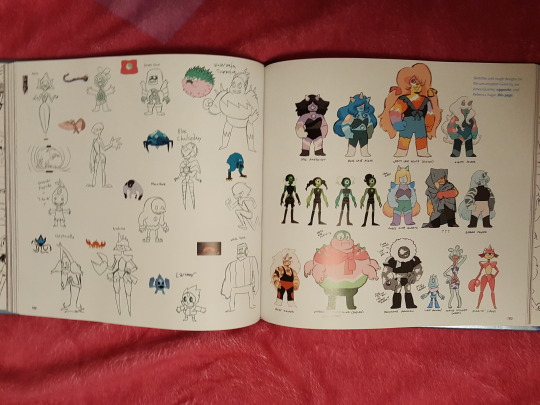
18.
The Rhodonite side story would have been about the love story of a Ruby and a Pearl working for Morganite. Images of Morganite and her servants, unfused, are in the book. We do not get this additional information, but Rebecca said in a panel shortly before the book's release that Rhodonite's story would have been about finding out that she had been Rejuvenated 17 times because her components kept falling in love and needing to be reset.
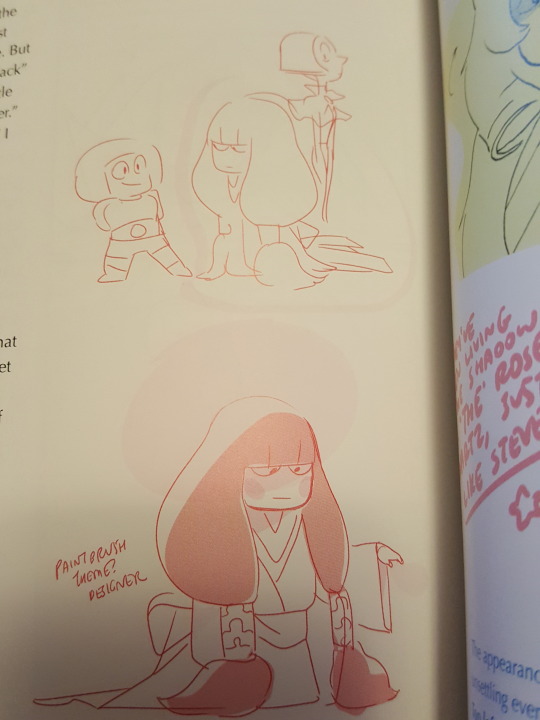
19.
Referring to the Diamonds on one of the charts, Steven's perspective is "I can't believe I helped these" and then there's a censor bar. Welp.
20.
Some included art by Hilary Florido features Kevin with a souped-up Koala Princess car and another where Kevin is staring at himself in the mirror in front of an altar to himself.
21.
Rebecca's sweater collection is included in the Crew art.
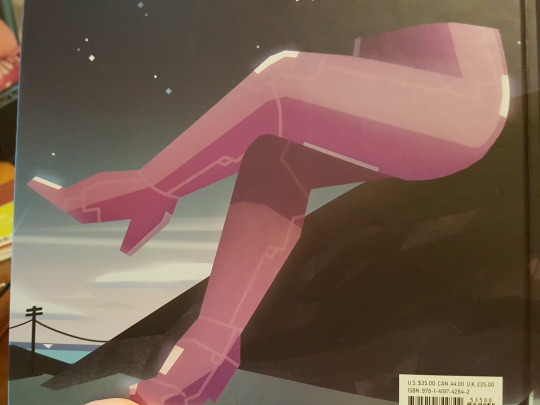
[SU Book and Comic Reviews]
167 notes
·
View notes
Photo

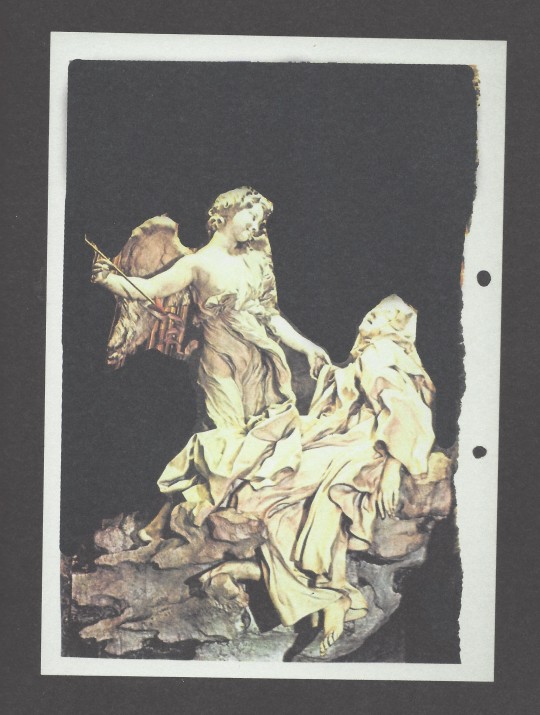
Journal For Plague Lovers part 6
Me And Stephen Hawking
“I think it says something about human nature that the only form of life we have created so far is purely destructive. We have created life in our own image.” – stephen hawking –
1/ Underground car park born at Stonehenge Rivers Wyle, Bourne, [blacked out] destroying Queen mother stuffed for exhibition Three strikes yr out – execution – pizza 2/ Dante III, spider robot, Mount Spurrr Increased plastic surgery for pubic hair Sanitation police, crime of proportion. [blacked out] 3/ Paisleyism and ecumenism and cenotaph bombers [blacked out] wearing policing Soviet labour medals sold for Coca Cola [blacked out] 4/ [blacked out] 82 million watch Gorilla Meets Whale [blacked out] [blacked out]
BRIDGE
Herman the bull and Tracy the sheep Transgenic milk containing human protein Their bacteria cheaper than lab baby food Attention, today it’s a cow, tomorrow it’s you
CHORUS
African Punch and Judy shows only rice price 100,000 watch Giant Haystacks Bombay fight Oh the joy, me and Stephen Hawking we laugh Missed the sex revolution when we failed the physical
hahahaha (joke)
[The image on the facing page is a marble sculpture titled St. Teresa in Ecstasy, by Gian Lorenzo Bernini, finished in 1652. It is in the Roman church of Santa Maria della Vittoria. It features Theresa in a state of ecstasy as an angel descends to plunge his hands into her heart.]
Reference explanations:
Most of these references are based off of news articles Richey read in 1994, either general summary-like references or nearly direct quotes from articles, mostly from The Indepedent.*
The Stephen Hawking quote is from a speech he gave at Boston's Macworld Expo quoted in the 4th August 1994 issue of the Daily News. A similar quote is in his 1996 lecture Life In The Universe.
Stonehenge is a prehistoric ring of standing stones. It’s managed by English Heritage and owned by the Crown. It is associated with death and burial, and bodies have been excavated in the area around the site. It is aligned to the sunset of the winter solstice and the opposing sunrise of the summer solstice. The ���underground car park” line is a reference to proposal made in 1994 to close the A303 and turn the road into an underground tunnel that will pass directly under the site of Stonehenge itself. (Apparently said proposal was approved November 2020.)
I think “Wyle” is a misspelling of “Wylye”, which is a river in south west England. River Bourne is nearby; both go through Wiltshire county. Said county contains the Salisbury Plain, which also contains Stonehenge. The Rivers Wylye and Bourne are both part of the Hampshire Avon catchment. In August ‘94 the county was granted a multi-million pound package to protect the catchment from pollution and monitor buildings developments and water flow rates.
The “queen mother” line may refer to the Queen Mother’s 90th birthday parade in 1990. The Queen mother celebrated her 94th birthday in 1994, and a few informal photos of her were released in The Mirror in an article about it.
“Three strikes yr out – execution – pizza” is a reference to the “three strikes rule” proposed in California. A rule was proposed 1994 and passed in 1995 that allowed someone to be sentenced to life in prison if it was their third repeat offense, and if they had a previous conviction for a violent offense. A man named Jerry Dewayne Williams was arrested July 30 1994 for stealing a slice of pizza and due to this law was later sentenced to 25 years to life.
Mount Spurr is an Alaskan mountain. Its last volcanic eruption was 1992. Dante II was a spider-like robot from NASA that explored Mt Spurr’s volcanic crater in order to gather information and entered the crater in July 1994. It managed to gather information but on the way out of the crater, got stuck in the mud and fell back into the crater. Not sure if “Dante III” is a mis-type.
Dante’s Inferno is about the main eponymous character entering Hell and traversing its rings in order to reach purgatory and then paradise to find his lover Beatrice.
“Increased plastic surgery for pubic hair” is a reference to an article in the The Independent on 27 August 1994 which talked about men getting plastic surgery and liposuction. (The article is titled “Men who want a perfect body,” which certainly hits upon one of Richey’s preoccupations.) It mentions that there are “more and more images for men to look at, in much the same way female images have been pushed for years.” In a paragraph about penis enlargement surgery, it mentions that a complication from said surgery can be ingrown pubic hairs.
“Sanitation police, crime of proportion.” is likely a reference to an article by Zoe Heller called “How I fell foul of New York’s sanitation police.” The Sanitation Police in NY are responsible for dealing with things like theft of recyclables, littering, illegal dumping, improper disposal of solid waste, etc. They can issue summonses for citizens who mix recyclable and non-recyclable materials (which, from what I can gather, is what the Heller article is about).
Ian Paisley was a loyalist politician and Protestant religious leader in Northern Ireland. He promoted a form of Biblical literalism and anti-Catholicism, which he described as “Bible Protestantism” In the mid-late 1960s, he led and instigated loyalist opposition to the Catholic civil rights movement in Northern Ireland. Throughout the Troubles, Paisley was seen as a firebrand and the face of hardline unionism. He opposed all attempts to resolve the conflict through power-sharing between unionists and Irish nationalists/republicans, and all attempts to involve the Republic of Ireland in Northern affairs. A retrospective article about him was published in The Independent in September 1994.
Ecumenism is any effort aimed at the unity of Christians throughout the world. Most often, it specifically means the visible unity of Christian churches in some form.
“Cenotaph bombers” is a reference to the Remembrance Day Bombing that took place 8 November 1987 in Enniskillen, Northern Ireland. An IRA bomb was detonated near a war memorial during a Remembrance Sunday ceremony. 11 people were killed and 63 injured. The IRA’s target had been soldiers parading to the memorial, not civilians. In August 1994, a ceasefire was announced by the Provisional IRA. In reaction to the ceasefire, Ian Paisley claimed that Northern Ireland would plummet into civil war.
“Soviet labour medals sold for Coca Cola.” The Soviet Union had medals for labour to honor workers for many years of hard work in the national economy, sciences, culture, education, manufacturing, healthcare, government agencies and public organizations. It was established in 1974 and stopped being awarded in 1991 after the dissolution of the Soviet Union. There was an article in The Independent on 5 April 1994 about a new British embassy being built in Berlin. It mentioned that the Russian embassy was next door, and that Russian traders would sit across the street from the embassy and sell post-war bric-a-brac like Lenin flags and Hero Of Socialist Labour medals.
“82 million watch Gorilla Meets Whale” is a reference to Godzilla, because the original Japanese name “Gojira” is a portmanteau of the words “gorira” (gorilla) and “kojira” (whale). By 1994, over 82 million people had seen the first 20 Godzilla films. Richey got that figure from an article in The Independent about the cultural history of the films and their critique of environmental and economic problems. The other thing I could find was a reference to the fact that Godzilla represented Japanese fear of nuclear testing etc: On March 1, 1954, the U.S. conducted a hydrogen bomb test called Bravo shot at Rongelap Atoll in the Marshall Islands. As a result of this nuclear test radioactive dust fell not only on many Marshall Islanders but famously on a Japanese tuna fishing boat called the 5th Lucky Dragon, irradiating all twenty-three fishermen. The effect of these nuclear tests on Japanese, a who had previously experienced the atomic bombing of Hiroshima and Nagasaki on the heels of the destruction by bombing of virtually all other major cities, was to strengthen anti-nuclear sentiments, giving rising to a powerful anti-nuclear movement that spread across Japan in the form of a citizens’ petition initiated by women opposing nuclear tests. The petition, the largest of its kind ever, was signed by 32 million Japanese. That August, the first Conference Against Atomic and Hydrogen Bombs was held in Hiroshima. The 5th Lucky Dragon became the model for the boat called “Eiko Maru” attacked by Godzilla.
Herman the bull was the first genetically modified bovine in the world. Scientists injected the embryo with human gene coding for lactoferrin. Eight calves were born from Herman in 1994. All calves inherited the lactoferrin production gene.
Tracy the sheep was a transgenically modified sheep in Scotland, made to produce alpha 1-antitrypsin, which is a substance that was regarded in the 1990s as a potential pharmaceutical for the treatments of emphysema and cystic fibrosis. Alpha 1-antitrypsin comprised 50% of the total protein in Tracy’s milk.
“Attention, today it’s a cow, tomorrow it’s you” is an almost direct copy of an anti-genetic modification poster from the Dutch society for prevention of cruelty of animals, which portrays a topless woman with udders in place of breasts over the caption: 'Today a cow, tomorrow you.”
Punch and Judy was a traditional puppet show. It was usually very violent, with the characters of Punch and Judy (or Punch and another character) fighting and hitting each other. It is handled by a single puppeteer, and audiences are encourage to participate a la panto. It comes from commedia dell’arte.
“Only rice price” may be a reference to a 1976 film called Network. I may be making connections where there aren’t any, though. “What’s that got to do with the price of [blank]?” is a well known phrase (usually it’s “the price of tea in China”). In Network, “the price of rice” is the phrase used. The main character is a new broadcaster whose channel is failing, and he threatens to commit suicide on air. This causes the channel viewing to go up, so the heads of the channel decide to exploit this and allow the character to say whatever he wants and generally spew angry tirades. Eventually he is killed. But the “rice price” line comes from a monologue in which the character berates those watching the show, and tells them that they never read books or newspapers and that television is not news, it’s entertainment and amusement parks. Television is described as being able to make or break people, and as “indifferent to suffering, insensitive to joy. All of life is reduced to the common rubble of banality.”
Giant Haystacks was a wrestler in the 70s. He was 6′11″ and weigh 638 pounds. There’s no info about him ever being in a fight in Bombay. The “Bombay fight” line could be a reference to the Bombay Riots that occurred in 92/93, but again there doesn’t seem to be any connection to Giant Haystacks.
Stephen Hawking is a theoretical physicist and cosmologist. He suffered from ALS or motor neuron disease, which left him paralyzed and necessitated the use of a speech-generating communication device. He worked with theories on relativity and black holes (which I do not understand and could not explain because I am not a scientist.) In 1988 he wrote A Brief History Of Time. He died in 2018.
The sexual revolution was a social movement started in the 60s and continued through 80s which challenged certain sexual and relationship norms/conventions. It argued for freedom to sex before marriage, right to abortions and the pill or other forms of contraception, normalization of pornography, homosexuality, other forms of sexuality, and public nudity.
*Many, many thanks to a reddit user who messaged me with all of this new information! They did a ton of research and found all these references in old newspaper archives and 80s/90s BBC documentaries, which I never would have thought to check.
28 notes
·
View notes
Text
Blog Post #1
In our first class we had an “Intro to Afrofuturism” and discussed the short film Pumzi. This is a science fiction short film that really got me to think about Afrofuturism and what it means in today’s world. To me, Afrofuturism is a broad movement that envisions a future for people of African descent that is rooted in their cultural experiences and traditions. I think that Asha’s character and her pursuit of a better future is truly empowering and beautiful in a deep way. When I saw that we have to watch Black Panther at home I got extremely excited. I would say that when I first watched it, I definitely became one of my favortie films. Besides the outstanding cast, I think there really is a beautiful message which could be taken from the film. Especially in regards to looking at it from the perspective of this class, I would say that Black Panther has made a huge impact on the black film community and the messages its aims to empart with its audience.
My next discussion I want to address in the Dirty computer film. After watching it partially in class, and then the rest at home, I got to gain a new understanding of what such a film could really mean. "Dirty Computer", a film by Janelle Monáe who is very prominent in the Afrofuturiast community, tells the story of Jane 57821, a young woman who is captured by a totalitarian government. She is labeled as a "dirty computer" because of her non-conformity to societal norms. I really appreciated how there was an emphasis on the importance human connection and the themes of technology was so evident. My favorite part would probably be that the main character is played so well. Through her amazing acting I was able to notice so many of the subtle messages that were being presented from the films themes. Also the film does have a really nice soundtrack that helps in its storytelling, and social commentary that the film is aiming to relay.
I would say that overall, I am really looking forward to seeing more about what this class has to offer. Specifically in how Professor Due approaches discussing topics that are new and foreign to me as a Political science major and senior at UCLA. So far, in just our few sessions together I think that I have already been introduced to so many new concepts that are extremely applicable to our modern world.
1 note
·
View note
Text
Anatomy of a Medical Drama: House, MD

This post is part of a series on the Anatomy of a Medical Drama.
The first thing to know about House, MD is that Dr. Gregory House is One Cranky Jerk.
The second thing to know about House, MD is that it isn’t a medical drama.
Oh, sure, it pretends to be. We get all the furniture of a medical drama: the dying patients, the worried family members, the gruff attending physician, the compassionate and sensitive younger doctors. We get death and we get life and we get medical miracles.
But that’s not the true genre of House.
House is a detective show. In fact, it’s a medical adaptation of the classic Sherlock Holmes.
Instead of a doctor, I want you to consider Greg House to be a detective. (Even the name House is supposed to get you to think of Holmes.) He’s arrogant, he’s rude, he’s problematic — and he’s brilliant.
Instead of a disease, I want you to consider whatever improbable virus, condition, or disease to be a criminal, a devious mastermind out to do harm. The symptoms, the actual disease process, are thus its crimes, and the patient is its victim. The loving family members are witnesses to the crime with valuable information for our detective, while the junior doctors, House’s intrepid fellows, are the junior detectives.
Lisa Cuddy, the hospital’s chief administrator, plays the role of obstructor and leader. She’s the less-than-brilliant chief who’s supposed to see things done the “right” way. She is the Lestrade to House’s Holmes; she’s there to get in his way.
And what would a Sherlock Holmes be without a Watson, or in this case, a Wilson? A best friend who enables and supports our main character not because he doesn’t see his flaws, but because he loves him in spite of them?
House, my friends, is a crime drama.
Thus we’ve discovered House, MD‘s Content Genre: Crime Drama (Medical), also known as a Diagnosis Drama.
The Reality Genre of the show is aimed to be Realistic, grounded in reality and the cutting-edge medicine of the day. The rules of the world are ostensibly the same as the one you and I live in: magic, elves, and science fiction take no part in this show. That said, the show’s connection to actual realistic medicine is tenuous at best, as we’ll discuss below.
What Makes House, MD Great?
There are a number of things that contributed to House, MD‘s success over its eight-year run.
First, the acting was great. Hugh Laurie brought depth and a tremendous amount of weight and poignancy to the character of Greg House. The supporting cast, including Lisa Edelstein (Cuddy), Robert Sean Leonard (Wilson), Jennifer Morrison (Cameron), Omar Epps (Foreman), and Jesse Spencer (Chase) made the first few seasons absolutely riveting, and adding in talent like Olivia Wilde (Hadley / “13”), Kal Penn (Kutner) and Peter Jacobson (Taub) in later seasons only improved things.
Second, House’s mindset is absolutely fascinating: Everybody Lies. (The question that makes things interesting is how they lie, to what degree they lie, and, most fascinating of all, why they lie; this is part of the fun of House, MD as a show.)
House has been criticized for being formulaic, and I can definitely agree that it is, and yet something in the formula that drove the show was incredibly compelling. House was always doing something absolutely crazy that we knew was wrong (because the episode was only half over), Cuddy and his staff were always trying to keep him on the sane and level path, and what’s even better, the show recognized it. It was acknowledged in multiple episodes, and even by House himself, that his colleagues were the reason House could stay sane and keep from killing his patients.
In fact, House and Wilson fall into (or at least adjacent to) the “Buddy Cop” trope, what Roger Ebert called a “Wunza” relationship: one of the pair is a calm, competent, mild-mannered oncologist, while the other is a dramatic, abrasive, neurotic, brilliant critical care doctor. It doesn’t contain all aspects of the traditional Buddy Cop relationship — we don’t see them hate each other in the beginning like we do with most buddy cops — but the relationship is there; we see it after it’s stabilized.
And that drama, that tension between the egomaniac with a syringe and a helpless patient and those who want the best for both of them, made House an incredibly tense show. That tension carried us through to the inevitable end — that House would solve the case, the patient would get better, and because the patient got better, all would be forgiven.
House also had consequences for the character’s actions that played out over multiple episodes. At the end of Season 1, House is shot because he was such a jerk — which resulted in his getting a certain kind of anesthesia (ketamine) which eliminated his pain and gave him the ability to walk and run pain-free again for a limited time at the start of Season 2.
House’s unorthodox treatments (such as prescribing cigarettes for Irritable Bowel Syndrome) landed him in hot water with Medicare, which threatened to pull his license. His constant abuse of drugs, a cornerstone of his character, landed him in rehab more than once, and addiction is a theme that plays its tune throughout the show.
All in all, House was a very good show with a lot of strong qualities.
Where Does House, MD Fail?
First, we need to get something out of the way: we get a lot of racism, sexism, homophobia, transphobia, etc. from House himself — he is, in a sense, the show’s social villain. He’s portrayed as a man so offensive that the only reason he keeps his job is because he’s too brilliant to fire for his childishness and gruff exterior.
That said, hearing some of the awful and offensive things he’s said come from a “medical professional” and the show’s protagonist is damaging and hurtful. There were ways the showrunners could have made House a jerk without resorting to insults based on someone’s identity.
(It’s also worth considering its place in time; the show ran from 2004-2012, an era in which minority voices were far less recognized in TV than they are even five years after the show’s end. )
The show fails the realism test on several fronts. In fact, speaking as an ICU paramedic, the medicine is often laughably inaccurate or hyperbolized. Things progress at a pace that suits dramatic storytelling, not reality; diseases layer that are astronomically unlikely; hell, House’s entire specialty — “Diagnostic Medicine” — doesn’t exist, because all doctors diagnose and all doctors treat.
But that’s not the big problem with the show. The biggest problem with the show are its ethics.
The number of unethical and outright illegal measures House takes to “get the job done” would have gotten any real doctor fired in their first year. They are, frankly, a scary thing to normalize in the minds of non-medical viewers.
Speaking of getting fired, fun fact: while medical staff who come to their employers and admit addiction to a substance are generally treated well — [estimates of substance abuse among nurses run from 10-20%] — they’re not allowed to practice stoned. Many employers will give time off for rehab, but staff must be compliant to practice.
Moreover, the repeated displays of unpunished bad behavior lends itself to a mindset that “the ends justify the means,” which is incredibly dangerous. A great many awful things have been “justified” in this manner.
Is It Good TV?
This is the most irritating part about House. Because with as many inaccuracies and flaws and mixed messages and damaging representations as the show has, as many bad stereotypes as it engaged with — it was still damn good TV, at least for the first 4 seasons. Characters changed, at least a little; the stakes were constantly escalating; House the Bully was often, let’s face it, hilarious in his cruelty.
House might have been bad in a great many senses, but it was damned compelling TV, and for all its faults, that fact is undeniable.
In short: House is great to watch, but don’t try to be a Greg House.
How Can We Write Like House?
If you wanted to produce a book, movie, or TV show along the lines of House, MD, my first suggestion would be to get very, very comfortable with the genre conventions and obligatory scenes of the crime drama, and consider how they can translate into medicine.
If we truly want to classify House, MD, we would likely call it a diagnosis drama to differentiate it from a crime drama, though really all that’s changed is the furniture.
Here are some of the Obligatory Scenes and Genre Conventions for a diagnosis drama, and the parallel scenes in a crime drama:
The Disease Strikes. (The Crime) Whether something has been building up for a while or comes to a head, we need to see a character felled by a disease or injury. This must occur early in the story/plotline and is essentially the Inciting Event.
The Doctor & The Team. (The Detective & Sidekick(s)) We must have a lead character, usually a doctor, trying to solve the medical puzzle, usually working with a team. The interpersonal dynamics of the team are crucial to establishing drama and hooking the audience.
Gather Symptoms and Information. (Interviewing Witnesses; Red Herrings.) The doctor must try to gain as much information as they can to solve the case. In House this often involves burglary for reasons not entirely clear.
Diagnose / Treat / Fail / Repeat. (Red Herrings & False Accusations) As the drama wears on, the patient gets worse, often by the hands of the doctor treating them. The team iterates over their work, trying new approaches that must get riskier and more dramatic as time goes on.
It Gets Personal. There must be some reason the doctor (and thus our audience) becomes closely entwined with the outcome of the case. Either the patient and doctor or team must form a personal bond, the doctor’s reputation must hang in the balance, or the rising tension between the team (who must think differently from the doctor) can only be resolved by solving the case and helping the patient.
The Final Diagnosis. (J’accuse!) The doctor must make a final diagnosis that will either save or kill the patient.
A Life Saved or a Life Lost. (The Justice Theme) Our story must end with either the patient’s life being saved or their life being lost. This may come with an ironic twist: the doctor may save the character at the expense of a relationship they value dearly.
If you’d be willing to take a piece of advice, though… check the misogyny, racism, homophobia, transphobia, etc. at the door. Take the best things from this show, not the worst.
For more reading on genre conventions and obligatory scenes, I recommend Shawn Coyne’s excellent guide to editing, [The Story Grid], and Blake Snyder’s [Save the Cat!], both of which are excellent books on storytelling from wildly different, and yet similar, perspectives.
What Medical Drama Should I Analyze Next?
Drop a comment or reblog and let me know!
xoxo, Aunt Scripty
[disclaimer]
[Free Email Course: Injuries in Storytelling]
Anatomy of a Medical Drama: House, MD was originally published on ScriptMedicBlog.com
#anatomy of a medical drama#content genres#genre conventions#genres#medical ethics#obligatory scenes#reality genres#masterposts#crossposts
450 notes
·
View notes
Link
How do celebrities become so popular?I've always found that whole concept really interesting.With enough exposure, celebrities can build up a huge following of raving fans.Most of those fans have never even met their idols in real life, yet they'll defend them at every turn because of how much they like them.The Mere-exposure effect helps explain one of the reasons why... and it can also help you close more clients.Yay. Go science!The post below is a text version of a live stream recorded inside the Client Science Facebook group. If you prefer watching video instead of reading text then join us there, and you'll find the recording saved to the group.What is the Mere-exposure effect?In one of the best known studies of the mere-effect by Robert Zajonc, who is widely known for developing the theory, participants were shown various images that they didn’t already have a preconceived bias; foreign words, Chinese characters, and faces of strangers. They were then asked to rate how much they liked those images.Some people in the study were not shown the images at all before being asked to rate them, some were shown them once, some multiple times, and some up to 25 times.The results were clear - the more they were exposed to an image, the higher it was rated.This effect has been studied over and over again by different researchers, proving it to work for almost anything, including paintings, colors, flavors, and geometric figures.In a nut shell; the more we see or hear something, the more we like it.Because of the way this works, it's also sometimes called the Familiarity Principle.So, how can you use it to close more clients?It's the basis for most advertising activities - show people your product enough and they'll start to like it. But I also think there are a few other ways we can leverage this effect. Let me know in the comments if you can think of any others...Be More VisibleIf you're selling t-shirts to customers for $9.95 then you probably don't need to spend time leveraging this effect. It's a commodity without a high transaction barrier. But if you're trying to sign clients (e.g. high-ticket products and services) then you definitely need your prospects to like you before they'll even consider buying.Since repeated exposure makes you more likeable, then the obvious answer is to be more visible.I know that's easier said than done, but for those of you still hiding behind your laptops understanding the concept of why it works might help kick you into gear.Get your face and company name out there and in front of your audience as much as possible. Your YouTube channel, lives streams, blog posts, social media posts, event appearances, and networking efforts all help to increase your exposure and make your potential clients prefer YOU over the competition.What's even more interesting is that to get the desired effect studies have shown you don't even need to have a conversation or hear them speak. Just by sitting silently in the same room as someone, you can double the chances someone will agree to something you ask of them.So even something as simple as having pictures of your sales team up on your site can help. When it comes time for a sales call, potential clients will think more positively of the person on the other side of the video call, and they'll be more likely to buy.By simply reading this post, your opinion of me has also grown more positive. I tricked you with science!Repeat Your Unique Selling Proposition (USP) Early and OftenSince the mere-effect isn't just isolated to people, it also works with words, repeat your USP as often as possible and your potential clients will love it more and more.A very non-scientific example for illustration purposes:The first time they see your USP... they won't even notice it.The second time they see your USP... they'll notice it but pay it no mind.The third time they see your USP... they think it's average.The fourth time they see your USP... they think it's got slight merit.The fifth time they see your USP... they think it's a good idea....the tenth time they see your USP they think it's amazing and is worth paying hand over fist to get it.Use a Well Known Website StructureStand out with you brand, messaging and USP. Not with the structure of your site.When it comes to website structure and user flow, don't try and re-invent the wheel.The actual structure of the site (where the categories are, where the sign up links live, where to position the shopping cart, etc) should be the same as other major sites in you niche.A familiar site structure and flow allows your prospect to easily navigate you site, it also feels comfortable and familiar, and they'll like you (or more specifically, the site) because of it.The effect is less strong on childrenIf you're in a niche aimed towards children, then the bad news is that studies have shown the effect isn't as strong with children. It's thought this is because children value new things over the familiar.The good news is that in most niches aimed at children the real target market is actually the parents buying the product. So shift you thinking to how you can leverage the mere-exposure effect with them instead.It Works SubliminallyThis is probably stepping an ethical grey area, but it's still super interesting.Studies have shown the effect to work even when the participants were unaware of the exposure.If you created a video and inserted nano-second images of your product into the video (that were imperceptible to the human eye) then by the end of the video people would also have a more positive opinion of that product.Obliviously this is unethical, but still, it's quite interesting.How else can this concept be leveraged for your business?Can you think of any examples in the wild?With enough repeated exposure, maybe you'll create your own raving fans!P.S. If you're interested in this stuff then come join us at the Client Science FB group, where we talk about these things in-depth.
0 notes
Text
Which Content Marketing Strategies Have the Biggest Impact on Keyword Rankings?
The term “content marketing” is a wide umbrella.
It encompasses a plethora of different strategies and techniques.
But at the end of the day, one of your primary goals is to create content that ranks as highly as possible on search engine results pages (SERPs).
This is important because organic traffic is the number one means of generating traffic for many companies.
A study from The Bright Edge even “found that organic search drives 51 percent of all visitors to B2B and B2C websites trumping all other non-organic channels.”
This means one thing.
You need to figure out the relationship between content marketing strategies and keyword rankings.
This is instrumental in fine-tuning your content marketing campaign and finding the right areas to focus on.
In this post, I analyze data from multiple studies and draw on my own knowledge and experience to give you a clear idea of the content strategies demanding the most attention.
So, let’s see which strategies have the biggest impact on keyword rankings.
Rich content
I won’t waste your time telling you about the importance of creating quality content.
You already know that.
But I’d like to share with you this statistic from an infographic on Quick Sprout:
That’s a lot of links!
And I’m sure you know the integral role links play in SEO.
This graph from Moz illustrates the importance of links and their influence on Google’s algorithm:
Let’s put this information together.
When you create rich content, it gets you more links.
These links improve your overall SEO, which improves your rankings.
So, being diligent about achieving and maintaining rigorous quality standards should be of the utmost concern.
Long-form content
Here’s the deal with long-form content.
It’s hot right now. Scorching hot.
I remember a few years ago when your average blog post was only somewhere around 500 words.
But if you look at the vast majority of content that ranks on page one of Google SERPs today, it’s rare that you’ll find anything under 1,000 words.
To prove just how important long-form has become, I would like to show you a couple of graphs.
The first is from a fairly old (September 2012) article I wrote on Quick Sprout.
I got the data from research performed by SerpIQ:
As you can see, every single piece of content that ranked on the first page had at least 2,000 words.
More specifically,
The first result typically has 2,416 words and the 10th result has 2,032 words.
Newer research (September 2016) from Brian Dean of Backlinko shows a similar pattern:
According to his research,
The average word count of a Google first page result is 1,890.
That’s over 500 words fewer than the original research from SerpIQ indicated back in 2012…526 to be exact.
But it still shows us long-form content is a key element in achieving solid rankings.
Why is this so?
The way I look at it, there are two main reasons for this phenomenon.
First, people have a tendency to scan through content these days.
Few actually sit down and read a 2,000-word piece word for word in its entirety.
Instead, they scan through and look at the sub-headers that grab their attention and may read little snippets of text from there.
Long-form content facilitates this new method of reading.
Second, a longer word count tends to translate into more links.
And this makes sense.
The more content you provide, the more opportunities for it to be linked to.
Put all this together, and you can see that long-form content means higher rankings.
Who knows, the whole “long-form content bubble” may pop in a few years.
But it’s stronger than ever at the moment.
However, it appears that the ideal word count has been reduced considerably, and you should aim for just south of 2,000 words.
How do you create 2,000-word content?
Decide on a specific and narrow topic.
Create a compelling title.
Discuss the issue from every angle.
Provide as much detail as possible.
If possible, provide step-by-step instructions on how to do something.
You should never stuff your articles with words just for the sake of hitting a word count.
But you should strive for detail, depth, clarity, and mastery of a subject matter.
Here’s what I’ve discovered about long-form content. When you truly make an effort to provide value in your content, it expands in length.
That’s not to say that you can’t provide value with a 400-word article.
But the level of value created in a 2,000-word article is usually much greater.
Content with “topical relevance”
But the plot thickens.
The same Backlinko article also points out that
content rated as “topically relevant” significantly outperformed content that didn’t cover a topic in-depth. Therefore, publishing focused content that covers a single topic may help with rankings.
Topical relevance basically combines my first two points of creating rich content and long-form content.
It simply means that Google values content that’s comprehensive and that thoroughly covers a topic.
This means it’s best to focus on a single topic for each piece of content you create.
Rather than bouncing around from subject to subject, you’re better off going all in on a single topic and leaving no stone unturned.
Does this mean you can’t discuss other topics?
No. In fact, you should touch on as many relevant topics as possible! But your focus should be on a single topic.
If you feel you need to cover a topic you weren’t able to get around to in the post, create a separate piece of content and cover it in-depth as well.
Using long-tail keywords
This strategy has been in existence seemingly since the dawn of SEO—back when SEO was in its primordial soup stage.
One of the main ways small-scale marketers have been competing with the big dogs is by using long-tail keywords.
And why wouldn’t they? It freaking works.
In fact, I’ve been using this strategy for years.
I even used it to grow my search traffic by 51% in just three months!
And guess what? It still works brilliantly.
An infographic from Adept states that “pages optimized for long-tail keywords move up 11 positions on average, compared to just 5 positions for head keywords.”
It’s really not rocket science.
Using long-tail keywords means less competition, which means a greater likelihood of achieving a favorable ranking.
The awesome thing is that long-tail searches account for roughly 70 percent of searches:
This means there’s plenty of opportunity out there.
Of course, you won’t get the same volume of traffic that you would for a head keyword or broad keyword, but you can still generate some sizable traffic if you do your keyword research and choose a phrase that receives a reasonable number of searches.
Check out this post from NeilPatel.com for a step-by-step walkthrough of integrating long-tail keywords into your blog posts.
The process is fairly straightforward:
Do your typical keyword research (using Google AdWords Keyword Planner or your preferred tool)
Select the long-tail keywords from the list (3 words or more)
Use these keywords in your content.
Image-rich content
If you haven’t heard, people respond positively to images.
It’s true.
And although I think the whole visual-centric discussion has been done to death, I would like to reference one more point from the Backlinko article I mentioned earlier.
According to Brian Dean,
Industry studies have found that image-rich pages tend to generate more total views and social shares.
But here’s the interesting thing.
Using at least one image is much better than not using any images at all.
However, they couldn’t find a correlation between the total number of images and rankings.
That means there’s no proof that using a lot of images will improve your rankings any further.
In other words, using just one image would in theory have the same effect as using 10 or more images.
The key takeaway is this:
Using a single image is clearly better than zero images. Including lots of images doesn’t seem to have an impact on search engine rankings.
When it comes to my posts, this information isn’t going to stop me from sprinkling plenty of images throughout my content.
In fact, you probably know that many of my posts are jam-packed with images.
I think my audience enjoys the “eye candy,” and graphs in particular are excellent for explaining fairly complex concepts.
But keep this in mind when creating your next piece of content: going nuts with images probably isn’t necessary.
Direct answers
If you’re not sure what I mean by “direct answers,” it’s simple.
Google is now starting to show direct answers when you use a “how to,” “what is,” “who is,” etc. type of search.
Here’s an example:
The first thing that pops up at the top of the page is a clip from the top ranking site.
It’s a way to streamline the process and offer searchers direct information without them having to actually click on the link.
Of course, oftentimes they’ll still click on the link to find more in-depth information.
I know I often do.
So, here’s the deal.
Providing a direct answer can be beneficial and a viable strategy for killing it on SERPs.
If you can provide a quick, logical, and direct answer, especially for a long-tail keyword phrase, there’s a good chance you can get your content featured at the top.
Just be sure your direct answer transitions smoothly into the rest of your content.
Here’s how I typically use this strategy:
Identify a question marketers are asking.
Create an article answering this question.
Provide a step-by-step solution to the issue.
When I follow this three-step process, the articles I write on those topics usually rank on page one for the associated keyword within five days or less.
This is the primary technique I’m currently using on NeilPatel.com, and it’s earned me over 800,000 unique monthly visitors.
Conclusion
I value objectivity when determining the approach of my content marketing strategy.
I find that examining the cold hard facts clears most biases and preconceived notions I might have.
This is important because this gives me the clearest path to achieving my goals.
While there are countless factors that contribute to keyword rankings, the ones I listed here appear to have the biggest impact pound-for-pound.
Putting your attention on these key areas should ensure that your content marketing is heading in the right direction while giving you the best chance of climbing in the SERPs.
https://www.quicksprout.com/2019/03/27/which-content-marketing-strategies-have-the-biggest-impact-on-keyword-rankings/ Read more here - http://review-and-bonuss.blogspot.com/2019/03/which-content-marketing-strategies-have.html
0 notes
Photo

New Post has been published on http://usviraltrends.com/new-delhi-berlin-london-updates-from-the-2018-march-for-science-science/
New Delhi, Berlin, London: Updates from the 2018 March for Science | Science
The March for Science in New Delhi earlier today.
Manoj Kumar
By Science News StaffApr. 14, 2018 , 12:11 AM
The March for Science is celebrating its anniversary today. And while the numbers may be smaller than last year, supporters haven’t lost any of their energy.
The global grassroots movement has evolved from having a million people take to the streets in 2017 in more than 450 cities to year-round advocacy for science and for evidence-based policies by government officials. But 14 April is still the big event for many local groups.
We’ll be covering some of those activities throughout the day. Come back to ScienceInsider for reports from the field.
Message of support from Antarctica: overwinterer at the Neumayer Station support the #MarchForScience @ScienceMarchDC @ScienceMarchGER pic.twitter.com/9yGPlJi0m9
— AWI Medien (@AWI_de) April 14, 2018
Uganda is ready for #MarchForScience!@nmugwanya @ScienceAlly pic.twitter.com/aLysGcpnll
— Ongu Isaac (@onguisaac) April 12, 2018
We did it @ScienceAlly #MarchForScience #Uganda pic.twitter.com/S5km901K1E
— Ongu Isaac (@onguisaac) April 14, 2018
‘Neighborhood nerds’ bring science to Berlin’s bars and cafes
BERLIN—No massive crowds at the Brandenburg Gate this year; the organizers of last year’s March for Science in Berlin—which drew more than 10,000 people and ended in a stirring song about freedom of thought—had instead invited scientists to meet with neighbors and other interested people in bars and cafes, an initiative named Kieznerds (“neighborhood nerds.”) After the 2017 success, another march might have become a “poor copy” that might even hurt the cause, says co-organizer Susann Morgner. So she and her colleagues asked Berlin’s watering holes if they would play host to scientists.
Some two dozen venues joined in, hosting talks about chemical experiments, animal communication, and viruses. One of them was La Tazza, a cafe in the trendy Prenzlauer Berg district whose owner, Delia Lemke, happens to be a professional science communicator. Some 10 guests sat at a long table for a discussion about “the importance of trust in modern times,” led by communication researcher Stefanie Molthagen-Schnöring of the University of Applied Sciences for Engineering and Economics in Berlin. (She and her husband have held similar debates at their home the past 3 years.)
To kick off the discussion, Molthagen-Schnöring cited alarming studies showing the diminished public trust in traditional media. She mentioned the work of German sociologist Niklas Luhmann, who has argued that trust reduces complexity. While trust between individuals or within organizations is a well-researched topic, trust within the public sphere deserves more study, Molthagen-Schnöring said.
The group discussed several questions, including how trust can be re-established in the Middle East as a precondition for peace talks. A student in regional management wondered how trust can be reactivated after it has eroded; a futurologist explained the limits to his predictions, which made him more trustworthy, a teacher who also took part in the discussion said. A participant working in science communication argued that researchers and scientific press officers should be clear about limitations and mistakes in science in order to build trust.
Kieznerds organizers had hoped that a considerable part of the audience would be nonacademic. But while the group in La Tazza included an artist and an au pair from China, the majority had links to science. The problem may just be that Prenzlauer Berg is home to many young academics, Lemke says. On Tuesday, Molthagen-Schnöring will lead a discussion in a low-income neighborhood with run-down highrise buildings where she might find more Berliners who have no connection to science. — Hinnerk Feldwisch-Drentrup
Kieznerds organizers worried that after last year’s successful event, another march would just be a “poor copy.”
Hinnerk Feldwisch Drentrup
Near Downing Street, a small rally focussed on climate change
LONDON— A small but enthusiastic group of about 80 people turned up today for the March for Science in London, a far cry from the estimated 10,000 last year. As the sun shone and several members of the crowd stripped down to T-shirts for perhaps the first time this year, one attendee wondered whether people had been mistakenly put off by the recent spate of stormy weather. Organizer Jillian Sequeira, a conflict studies student at the London School of Economics, had another take. Since last year “the world hasn’t fallen apart,” she said, and the feeling of urgency that characterized the previous march has dissipated.
But that doesn’t mean the issues have gone away, Sequeira said. “Even though there are fewer people, the message is just as important as before,” said rally participant Toby Olsen, who was visiting from Rhode Island. “There’s not really an excuse for being quiet.”
Those present had a variety of reasons for attending. Guy Pearce, runs the Worthing and Hove branch of Skeptics in the Pub, said that he was concerned that science funding was not a priority for the government. “Science works,” said another attendee, Duncan Rasor. “When somebody undermines that … we need to show support.” A common motivation was concern about the impact of recent policy decisions, particularly in the United States. Emma Fernandes, a visiting environmental science student also from Rhode Island, said that she was there to protest the Trump administration’s roll-back of environmental protections.
She was in the right crowd. The list of speakers this year was dominated by environmental groups such as Friends of the Earth, climate researchers, and self-proclaimed activists, so climate change was inevitably high on the agenda. “Science must play a central role in the pursuit of climate justice,” said speaker Rupert Stuart-Smith of the UK Youth Climate Coalition. Sequeira said this focus was intentional: While last year’s talks were mainly given by people from research institutes, this year she wanted to connect people with local organizations that they could get involved with—and most of those were groups involved in climate work.
There was no actual marching this year, but the 2-hour rally took place just across the road from Downing Street, the crowd mirroring the cluster of tourists hoping to get a glance at Prime Minister Theresa May. And given the focus of the day’s talks, the location seemed appropriate. Dorothy Guerrero of advocacy group Global Justice Now summed it up: “Science is political.” —Matt Warren
“There’s not really an excuse for being quiet,” says Toby Olsen (left), who attended the London rally with Emma Fernandes (right).
Matt Warren
A sign at the London rally.
Matt Warren
On the streets of New Delhi, to “keep alive the tradition of asking critical questions”
NEW DELHI—Last year, Indian scientists and science supporters didn’t march on 22 April, the day rallies were held in Washington, D.C., and around the globe, but more than three months later, on 9 August. This year, they took to the streets on the same day as the rest of the world. Marchers in New Delhi, pictured below, demanded that India’s investment in research and development increase to 3% of gross domestic product and asked for better science education and an end to unscientific thinking.
“For me the march is an opportunity to reach out to both members of the society as well as policymakers, to impress upon them the need to strengthen our scientific base,“ says Soumitro Banerjee of the Indian Institute of Science and Research in Kolkata, who participated in the Delhi march. Debabrata Ghosh, a professor at the All India Institute of Medical Sciences in New Delhi, had a wider audience in mind as well: “I attended the March in Delhi to keep alive the tradition of asking critical questions and to bridge the gap between scientists and non-scientists,” he says.
Marchers asked for India to spend 3% of its gross domestic product on science.
Manoj Singh
Don’t have your sign yet? Everyone is offering ideas
Last year, sign making parties were a popular pastime in the days before the March for Science. This year, a bevy of websites have put up stories aimed at giving marchers who might be at a loss for words (and pictures) a few ideas for their placards. A sampling:
At Thrillist, Joe McGauley offers “Funny, powerful and clever poster ideas for the science march this weekend.” I”[I]’s always a bit tough to figure out how best to get a message across in a sea of signs and chants,” he writes.
Don Duggan-Haas of the Paleontological Research Institution in Ithaca, New York, offers a few sign tips on the website of the National Association of Geoscience Teachers. “If science saved your life, or the life of a loved one, say it,” he writes. Then, you can “use the other side of your sign for your geoscience message.”
The website a plus has “13 awesome signs to inspire you before the march for science this weekend.”
And in case you missed it last year, STAT had “The 31 best signs people took to the March for Science.” And Bustle had “30 funny March for Science sign ideas.”
On Twitter, some folks say they are having a hard time deciding on their message:
Brainstorming for tomorrow’s #MarchForScience and I think I have hit a wall (and can’t find the rest of the markers.)
Don’t worry @FieldMuseum I will work on something a bit more, uhh, creative. pic.twitter.com/PQJ6v9dUeA
— Heidi (@heidyhoho) April 14, 2018
The marching is underway in Australia
Hours away from the beginning of the March for Science here in the eastern United States, the marching got started elsewhere around the globe. In Australia, events are planned for at least eight cities.
It was a small but enthusiastic crowd in Sydney. I look forward to updates as the #MarchforScience rolls around the world! pic.twitter.com/WgTuXYpY9F
— Lisa A. Williams (@williamslisaphd) April 14, 2018
And we’re off!!#marchforsciencesydney #sciencemarchau #sciencenotsilence pic.twitter.com/RWP2Z2oUSl
— GB-WildLyf (@MistressGeorge) April 14, 2018
March for Science in Townsville. So inspiring! #ScienceMarchTSV #ScienceMarchAu #ScienceNotSilence #KeepMarching #MarchForScience @RACI_HQ @RACI_Inorganic @RACIQld #ozchem @jcu @peterjunk2 pic.twitter.com/zB5Tz3I0hl
— Vicki Junk (@VickiJunk) April 14, 2018
Narrandera has now been added as an official #MarchForScience location! pic.twitter.com/GIxbFvB2F0
— Fiona Caldarevic (@FionaMagic) April 14, 2018
Global March for Science 2018. Kickoff in Sydney. Many thanks to organising team. Adam Spencer super MC. Focusing on need for science @iSTEMAustralia pic.twitter.com/g00WWusmCR
— Ken Silburn (@KenSilburn) April 14, 2018
In Virginia, ‘it will be different this year’
One person preparing for today’s event is Margaret Breslau, who last year helped lead a March for Science in Blacksburg, Virginia, that attracted more than 900 people. This year, she’s not sure how many people might show up, and she expects the tone of the march to be different. Instead of focusing on science “with a big S,” she says, she expects speakers and marchers to focus more on how the work scientists do affects social issues. Speakers, for example, plan to read statements from incarcerated people about the environmental and health conditions in prisons. There’s also likely to be discussion about a controversial local pipeline project and climate change.
“For me, it’s not just speaking out against the people and administrations denying science and defunding science and discrediting science,” says Breslau, who chairs Blacksburg’s Coalition for Social Justice. “I also want people to know that people are impacted every day by science, for better or worse. Science has incredible power. I think a lot of scientists probably do factor this in, but there has to be a human good.”
She credits March for Science organizers with maintaining communications since last year’s event. “They’ve been very good about it,” she says. “I found they’ve stayed engaged, and that’s really important. You have a lot of power in your hands when you do a national march, and keeping the energy up and the education is hard. I just can’t imagine. They’ve kept me engaged.”
And she doesn’t see this year’s march as the end of her engagement. “We have to keep building on what happens,” Breslau says. “As long as scientists are being silenced and cuts to education and programs [are happening] … you just have to keep going, that’s all.” —Catherine Matacic
Marches make a statement in the Philippines, Africa and Europe
Large and small, events are underway around the globe. Click here to see a map of all the scheduled March for Science events. Twitter is a good place to see what’s happening on the ground:
Not even the rain could stop science allies to ‘pour’ onto the streets of Kampala to #marchforscience @ScienceAlly @nbstv pic.twitter.com/Tah54IxPYH
— Nassib Mugwanya (@nmugwanya) April 14, 2018
Agham-Advocates of Science &Technology for the People joined other scientists in holding the March for Science Philippines #marchforscience pic.twitter.com/4dMNvKvBqr
— Agham Youth UPManila (@aghamyouth_upm) April 23, 2017
It is amazing how UKZN staff, students and various stakeholders have come in numbers to support the March for Science which starts at Durban City Hall. pic.twitter.com/alpN4EDOMI
— University of KZN (@UKZN) April 14, 2018
0 notes
Text
A Primer for Social Media Marketing on Visual Marketing
Take a look at your Facebook News Feed and tell me what you see — there’s a good chance that it is full of funny memes, pictures of cute dogs, or screencaps from popular films or TV shows.
Say what you will about humanity, but if there’s one thing that mathematics and experience have taught me, it is that we love looking at things.
(That is the area where I bombard you with all amounts — just so that we will not have to do so afterwards, so I hope you stay with me a bit longer here)
Findings from the Social Science Research Network show that 65% of human beings are visual learners.
A study by 3M Corporationreveals that 90% of information which enters the mind is anti inflammatory.
Non-verbal communication constitutes roughly 93 percent of human communication, states psychologist Albert Mehrabian.
The SAGE Handbook of Political Communication claims that the mind requires 1/10th of a second to process visual information — 60,000 times faster than the rate text. It does so for 50% of all information gathered by our visual receptors (based on E.N. Merieb and K. Hoehn’s Human Anatomy and Physiology, 7th edition).
Additionally, studies on social media use reveal some interesting statistics on visual content across social media platforms which social media managers
In 2014, there was a 75% increase in the amount of Facebook video articles per person across the globe — as well as a 94% growth in the USA alone.
Based on HubSpot, adding persuasive visual elements to an article has been demonstrated to increase engagements from targeted customers by around 37%.
A study by Socialbakers.com showed that articles with pictures experienced the most participation, containing about 87 percent of total connections.
An account by MDG advertising states that adding graphics and engaging visual elements to your elements could bring about a 94% increase in opinion count; additionally, press releases along with photos have been seen 14 percent more, while those with both videos and photos undergone a 48% increase in opinion count.
Now that we’ve spent a little bit of time looking at the numbers, let us get to the meat of today’s discussion: Visual marketing, and how it can be applied to a social media pages.
Visual advertisements encompasses all visual content which you could share on interpersonal media to tell your brand story. It can be infographics, videos, photos, illustrations, as well as the design elements on your pages. With the right visual elements for your social media pages, you are able to leave an enduring impression on your target audience and promote engagement.
Listed below are some of the most crucial reasons why your interpersonal media pages will gain from becoming infused with great visual marketing elements.
1. Good visual content will allow you to stand out from the audience.
Could you imagine precisely how many manufacturers you are competing on a daily basis? Millions of consumers upload videos, share photos, and article updates on their societal media accounts every day — and that includes companies, also! Consider it: Can your manufacturer be in a position to stand out at a sea of upgrades if all you’ve got to provide your viewers are walls on walls of text? There’s a principle of storytelling which I really enjoy — “Show, don’t tell.” If you are operating a restaurant, for example, which approach do you think would be more effective in convincing your audience that your food is exceptional: Telling them at a 200-word, adjective-laden status update, or simply publishing an album of your tasty offerings?
2. Visuals are less difficult to comprehend.
As I’ve been revealed previously in this blog article, visual elements are more readily absorbed and processed by your mind than enormous walls of text. I am sure even you’d agree that it is a bit more hard to receive a message that you will need to read paragraphs of text simply to grasp — doubly so if you are in a rush and the newest gets a couple of seconds to get you to comprehend what it is trying to tell you. A terrific visual is advice within an easy-to-digest capsule; it is your message encoded into the point where all the consumer has to do next would be to take action.
3. Visuals influence human emotions and decision-making.
Visual make people believe things. When it’s an overwhelming feeling of fuzzy hot goodness over a photograph of a kitten and a kid owl making friends, nostalgia at the sight of an old film or TV show that they had to watch in their youth, or pride (along with the so-called “recovery of faith in humanity”) over viral photographs of heroic acts, visual articles elicits special emotions from the viewers, eventually compelling them to take action.
4. Good visual articles can bring in lots of followers, enjoys, shares , and leads.
Any social media strategy will gain from a well-developed visual marketing strategy, only because it can and will show results. If your articles goes viral — that means that if a great deal of users share your infographic, photograph, or video — it is nearly a guarantee which you will notice a boost on your amount of followers thanks to its increased shares, enjoys, and remarks because it brings your articles to a far wider and varied Internet audience. Therefore, virality means more followers, which in turn means more leads for your brand.
Virality is a good goal to aim for on your social media strategy. But it is actually a hit or miss type of bargain. Here are some tips that you might Discover useful in successfully making your visual marketing campaign on social websites go viral:
Make sure that your visuals are appropriate for your brand and content.
The arrangement matters, also — consider whether you will need an infographic, a photograph, or some other type of visual content.
Don’t be reluctant to inject a little humor in your content.
Base your articles on your target audience’s needs and preferences.
Figure out the ideal times daily to post your articles.
Don’t try to overcomplicate this campaign. Remember, aim for persuasive, not confusing.
5. Visual content promotes engagement and will develop brand loyalty.
Upgrades with videos and photos are a lot more inclined to be shared with your followers than text upgrades. As a matter of fact, your interesting visuals are a significant factor in assisting you to maintain your audience. By making your message easier to understand through visual content, your audience is more inclined to remain on your webpage and gain a much better grasp of your value proposition and what you could do for them which others can not.
Visual promotion is hardly rocket science; actually, social media has become a significant part of it for quite some time already. It’s been used by many manufacturers over the years and has been proven to be quite effective. With great visual advertising, you are able to make sure that your message gets to your viewer’s heads — so you will not bore them out of their skulls.
from Affordable Search Engine Optimisation From Mannys http://www.mannyscarwash.com/a-primer-for-social-media-marketing-on-visual-marketing/
0 notes
Text
PERIOD BRAIN AND THE MEDIA
You’re on your period. And yes, you have cramps. But do we experience a decline or increase in cognitive power because it’s that time of the month? I’m sure you’re familiar with the popular belief that as women we suffer ‘period brain’. The phenomenon has been of great interest to researchers since the 1930s (Poromaa & Gingnell, 2014) but ladies it’s time evaluate the true extent of ‘period brain’ and where it came from.
In the past, there has been a lot of research conducted that investigates whether there is a link between changes in hormone levels during a woman’s menstrual cycle and their cognitive ability. More recently, the methodology in menstrual cycle studies has been improved and therefore limitations with past studies have been identified (Pormomaa & Gingell, 2014). Many of the studies have failed to a find significant or reliable relationships between the variables (Sundstrom Poromaa and Gingnell, 2014 as cited by Leeners et al., 2017). Put simply, for those of you that just got out of bed, their findings don’t give accurate evidence for ‘period brain’ but this may be why some people think they do… Sherwin (2012) found that past studies provide evidence that supports that performance in cognitive tasks is influenced by fluctuations in female sex hormones during the menstrual cycle- in short it supports ‘period brain’. However, Sherwin argued that the extent of changes that have been found in most of the studies indicate that the results are likely not significant. From this we could draw the conclusion that methodological issues may have resulted in findings being published that are not significant. Could it then be argued that the idea of ‘period brain’ has stemmed from non-significant findings and therefore has been reported incorrectly? Yes ladies you guessed it! It can, but who’s the culprit?
The media tend to report on popular psychological topics, such as the menstrual cycle in relation to cognition, and aim this at a wide audience that wants to quickly understand the topic. However, they are often not experts in the topics they report and therefore they can draw incorrect conclusions from academic resources. This could be because of a thing called conformation bias, meaning they are looking for information that supports a belief they already have to make what they publish interesting. For example, a lady wrote an article in The Debrief that claimed, ‘period brain’ is a real thing because a google search brought up forums of women confirming it. Really Natasha? Haven’t you heard of the saying ‘don’t believe everything you read on the internet’. Although, she does go on to give the disclaimer that medical researchers (THE PROFESSIONALS) are not 100% sure ‘period brain’ exists. This article was wrote by a woman who was not an expert and already believed her decline in cognitive abilities was due to her period suggesting that the source is not reliable or accurate and may have been subject to confirmation bias due to the nature of her own experiences. However, for a member of the general public, who is also not an expert, this article may serve as evidence and it could be argued that this is one of the ways a warped version of ‘period brain’ has become a popular belief. Except now you lovely ladies know not to believe everything the media says but please, someone tell Natasha that!
“Let’s talk about sex baby! Let’s talk about you and me…”

Yes, you guessed it, it’s time to talk about sex! Just about everyone has heard that women are more attracted to men at different times through their menstrual cycle and these guys agree… Bibawi, Cherry & Hellige (1995) observed that female mate preference varies through the phases of the menstrual cycle. According to Macrae (2002) women are more efficient at person perception when ovulating. And Gangestad (2002) found that when women are more fertile they become sexually interested in men other than their boyfriend or husband and even have more sexual attraction to the other men than their significant other (awkward). Basically, we are better at finding our type when we are more fertile and fancy men other than our partners. But is that true? Wood (2014) found conflicting evidence in that women at different menstrual phases, fertile and non-fertile, significantly favoured men with the same attributes. But of course, the media had to stir the pot. The daily mail reported that women are twice as likely to cheat on their husbands when they are ovulating and up to now it’s had 78 shares and 222 comments. Nowhere in their article do they include that there’s conflicting evidence and that their claims might not be completely true or accurate. Unfortunately, the majority of the readers will not read any academic resources that dispute this and again the media feed the ‘period brain’ monster. Sad face ☹
But let’s not end this on a negative. You have successfully read (and hopefully understood) my blog post. Congratulations! And now you have been equipped with the knowledge to not always believe everything you hear from the media and you know lots of information on ‘period brain’. And for those readers who skip to the conclusion for a brief summary- here it comes, but you’re missing out! ‘Period brain’, although to some extend true, seems to have been blown entirely out of the water. Overtime it has been warped and distorted to become a not so accurate version of itself. We don’t have one person or organisation to entirely blame but it is clear that the media has influenced some of its deformities. Fingers crossed that in the future we will see ‘period brain’ accurately presented through further research and by educating society.
References:
Gangestad, S. W., Thornhill, R., & Garver, C. E. (2002). Changes in women's sexual interests and their partner's mate–retention tactics across the menstrual cycle: evidence for shifting conflicts of interest. Proceedings of the Royal Society of London B: Biological Sciences, 269(1494), 975-982.
Leeners, B., Kruger, T.H.C., Geraedts, K., (…) et al. (2017). Lack of associations between female hormone levels and visuospatial working memory, divided attention and cognitive bias across two consecutive menstrual cycles. Frontiers in Behavioural Neuroscience, https://doi.org/10.3389/fnbeh.2017.00120
Macrae, C. N., Alnwick, K. A., Milne, A. B., & Schloerscheidt, A. M. (2002). Person perception across the menstrual cycle: Hormonal influences on social-cognitive functioning. Psychological Science, 13(6), 532-536.
Poromaa, I. S., & Gingnell, M. (2014). Menstrual cycle influence on cognitive function and emotion processing—from a reproductive perspective. Frontiers in neuroscience, 8.
Sherwin, B. B. (2012). Estrogen and cognitive functioning in women: lessons we have learned. Behav. Neurosci. 126, 123–127. doi: 10.1037/a0025539
Wood, W., Kressel, L., Joshi, P. D., & Louie, B. (2014). Meta-analysis of menstrual cycle effects on women’s mate preferences. Emotion Review, 6(3), 229-249.
Bibliography:
https://thedebrief.co.uk/news/real-life/period-brain/
http://www.dailymail.co.uk/health/article-3891172/Why-time-month-makes-TWICE-likely-CHEAT-Periods-make-women-smarter-sexier-tempted-stray.html
0 notes
Text
How To Make A Testimonial Video That Closes More Sales For Your Business
By Victor Blasco
Testimonial videos help businesses close sales. This is a fact that nobody can deny.
But do you know why that is?
It’s because testimonial videos build brand trust. Trust is the deciding factor for whether or not your customers will make a purchase – if they don’t trust your brand, they’ll back out.
Testimonials provide evidence that your product or service actually works as promised. In fact, 90% of customers admit that their buying decisions are heavily influenced by online reviews.
In this post, I’ll discuss what a testimonial video actually is, and how to make a great one for your business.
Let’s get started!
What is a testimonial video?
In simple terms, it’s a means for you to showcase the rave reviews of happy customers and allow them to personally vouch for the hard work you put into your product or service. It’s living proof that you provide value to your prospects, and a highly effective way to speak directly to website visitors.
It taps into the universal truth that we are all influenced by the opinions of others to some extent – a website with a customer testimonial video will inevitably generate more leads and close more sales than a website with no testimonial page at all.
Think about it: you can tell potential customers your product or service is brilliant until your lips turn blue, but it will never prove as powerful as showing real customers sharing their success stories.
A good testimonial video will always involve a real customer of yours endorsing your brand and your product. This customer will ideally be someone that once had the same struggles as your current prospects, and found a real solution in your offering.
Why not just use text testimonials?
Text testimonials are all well and good, but they fail to utilize one of your most powerful marketing tools – video. Not to mention that video testimonials are far more engaging and convincing than a page full of text. They will help reduce your bounce rate by keeping visitors on your site for longer and increase the odds that new visitors will feel confident enough to make a purchase.
We hear a lot in today’s world about how people are responding more and more strongly to visual marketing. According to TapSnap, visual content performs 4.4 times better than text-based content and 65% of audiences are visual learners.
Website visitors are also 64% more likely to buy a product on an online retail site after watching a video.
How do I prepare for making a testimonial video?
First and foremost, think about how your video should feel. The key terms you’re aiming for are ‘natural’ and ‘authentic’. A good testimonial video should also feel relatable: it has to feature real fans of your brand and natural, unscripted responses.
Why? Because nobody will believe someone sprouting a rehearsed or robotic opinion! Don’t be scared to show your real customers telling their real stories to ensure your testimonial video is engaging, credible and enjoyable.
That doesn’t mean you shouldn’t put some planning into producing one. Creating video content can be tricky so enlist the help of people who know what they’re doing, including writers, filmmakers, video editors, graphic designers and animators.
Prepare a list of questions in advance, but don’t be too attached to them or get upset if your customer goes off track!
Remember that your featured customers are doing you a favor and treat their time as the precious commodity that it is. Plan ahead so everything runs smoothly, prepare the types of questions you want them to answer and be ready to prompt them if required.
This will not only help you get all the information you need, but also make your testimonial video feel professional and natural. Instead of having an interview with your ‘testifying’ customers, you could even try to make it a conversation.
Always give your subjects plenty of time to elaborate. You probably only have one chance to get them on camera. It’s always better to have too much information than to have too little.
What do I need to do during filming?
During filming, you need to remember to give context to your video. For instance, are you recording this conversation inside of an office? Is this office located in San Francisco, Sydney, Buenos Aires, Tokyo… or Mars?
Show some shots that give context to your viewers to add a whole new level of credibility to the video. You might want to punch in a geographic location or list the specific place in which the interview is taking place.
Small details add visual interest as well as brand context.
Here’s a great example of this principle in action from Phelps Agency.
What is the most important thing to focus on?
It may sound a little negative, but the most important thing to focus on is the pain points.
Your customer’s pain points are what your audience will identify with the most. So don’t leave them out! Encourage your clients to talk about the problems they were experiencing and how they found a great solution in your product.
Providing evidence that your brand is capable of solving people’s pain points (and is not afraid of discussing them) will make your audiences trust you a whole lot more.
Try to focus on the specifics of each featured customer’s buying journey as much as possible to help audiences differentiate between them and show that you truly care.
How about the editing part?
It can be daunting to be faced with a whole pile of raw footage and limited time/resources to whip it into visual magic. You might want to outsource it to a video editing professional.
But if you edit it yourself, the main thing to remember is to edit wisely. You obviously don’t want your video to be too long, but you should take care not to leave out any important parts of the conversation.
Wise editing involves:
Stay true to what your interviewee has said
Use advanced editing techniques to give your testimonial a good rhythm
Layer music over the top (if appropriate)
Ensure everything is in high-definition
List any credits, make sure the sound is clear and consistent, and have some explanatory text surrounding the video so people know what they’re clicking on!
This WireBuzz HubSpot testimonial video is another good example of these elements in action:
It’s better to have a brief but powerful video than a long and boring one. Remember that above all else.
How do I promote my testimonial video?
So you’ve finally got your customer testimonial video ready and you’re really happy with how it looks. Great! Now it’s time to promote it.
Keep your video testimonials to one page on your website. Share them around with the featured customers and encourage them to share them with friends. You can even ask them to use a specific hashtag – chances are, they’ll be proud of helping you and will readily share it for you!
Be sure to let them know that any feedback is welcome and emphasize how much you appreciate their time and energy.
Next, send your testimonial video to non-featured customers who you think might be interested. Add a link to your testimonial page in your homepage, ‘About Us’ page and social profiles.
You might want to amp up the trajectory of your testimonial videos even more by posting it as an update on various social platforms. Simply write a catchy status like, ‘Want to see what our customers really think of us?” and ensure the link opens in a new tab.
If your business or brand has a LinkedIn Page, uses Google+ or other forums, put your testimonial videos front and center there as well.
Wrapping up
Testimonial videos are a form of high-quality content that can easily translate into customer trust, conversions and sales.
Showing a customer happily endorsing your brand is the best way to spark identification in your audience and give them the final reason they need to close a sale.
Remember to keep everything natural and ‘real’ – your customer’s testimony, your conversation with them and your video editing. Anything that seems rehearsed or scripted, loses credibility.
Oh, and never forget to get creative. To enlist customers to feature in your video, you can send out an email newsletter inviting them to showcase creative uses of your product or mount an iPad in your storefront or office where customers can leave their two cents worth in their own time!
Guest Author: Victor Blasco is the founder and CEO of Yum Yum Videos, an audiovisual designer and a video marketing expert. Aside from running his businesses, he loves studying Chinese philosophy and is a real geek about science fiction films and comics. The force is strong with this one. Follow Victor on LinkedIn here. See Yum Yum’s page about customer testimonial videos here.
The post How To Make A Testimonial Video That Closes More Sales For Your Business appeared first on Jeffbullas’s Blog.
The post How To Make A Testimonial Video That Closes More Sales For Your Business appeared first on Make It With Michael.
from How To Make A Testimonial Video That Closes More Sales For Your Business
0 notes
Text
The Novel Wave
In class we watched Jean-Luc Godard’s Hail Mary, and heard all about French New Wave cinema.
Lewis Bond - Breaking The Rules
youtube
https://www.youtube.com/watch?v=0R7R0JHvvgo
The story goes that in the 50s no one took film all that seriously, particularly those produced by Hollywood - they were entertainment - genre films, western, monster, romance ect. Then a small group of French film critics began taking the medium - previously dismissed as a lower form of entertainment - seriously, and began trying to develop a new language to describe it. Succeeding in turning film into an art-form in its own right.
Brophy tried to make a clear distinction between ‘criticism’ and ‘review’ by explaining that a reviewer talks about the film, whereas the critic talks about film.
A great proportion of this group of film critics then went on to become directors themselves including Francois Truffaut, Jean-Luc Godard, Claude Chabrol, Eric Rohmer, Jacques Rivette, Louis Malle, Alain Resnais, Agnes Varda and Jacques Demy. More than pulp cinema, these directors admired the work of Charlie Chaplin, Alfred Hitchcock, Orson Welles, Howard Hawks, and John Ford, which helped produce the ‘Auteur Theory’ - the idea that a director or film maker is an “author” - like the single creative force behind a book - with their own unique style.
"The 'New Wave' is neither a movement, nor a school, nor a group, it's a quality” - Truffaut (1961)
What made The New Wave possible was not just an understanding of the conventions that made Hollywood what it was, but also a relaxed attitude toward those rules. The groups playfulness became productive. Informed by much new science [relativity] and philosophy [phenomenology] (as always these things are all feedback loops) this playfulness extended into the relation between sound and image, which had until that point been simultaneous, and linear. With this new approach sound became far more relative, and flexible, which begs the question: what other kinds of time relations are possible?
“Photopgraphy is truth, and cinema is truth 24 times a second.” - Godard
The new wave didn’t destroy the old rules, they built on them, you have to understand what’s happening before you can subvert or pervert. [This class is an opportunity to pay close attention to what is happening in any sonic-visual relationship. For example, editing previous to the new wave was used to maintain continuity, a non-intrusive approach; editing was designed to be invisible. But New Wave directors had no problem drawing the audiences attention to the fact they were watching a film, or drawing attention to the edit itself. By demistifying these techniques, the audience is invited inside the film making process, not just the film. The films begin to do what they are.
You don’t need to show everything, but cutting out the excess often increased the pace of the film, our films now are far faster than they used to be. But when this much is cut, something has to take its place: the cut itself took the place of the needless footage, and this event becomes the new context. A kind of gestalt reversal - linked to the time-space I wrote about regarding Ghost In The Shell. The medium was no longer constrained to the whole, an edit, a shot, a camera move could be literary unto themselves. When you aren’t afraid of breaking some kind of illusion, it allows you to do other things.
At the end of his video essay Breaking The Rules, Lewis Bond tries to conclude by taking a key lesson away from the New Wave directors:
“look at what works in your medium and think ‘how can it be done differently?’“
But I think his advice is pretty shallow and dumb. Chances are, things that ‘work’ are invisible. And why would you arbitrarily do something ‘different’? Like the idea of just doing it better - better for who, for what? I think this is where critical theory (a la film criticism) steps in, and one of the great ways to approach this is to talk about what people don’t like, what we think is dumb, or bad. But instead of simply panning or dismissing it, take it deadly serious - which is what the new wave did. It saw the assumptions others made and took them as opportunities, to work with them.
Brophy: most European post war art becomes fractured - the old ways make no sense, so the old ideals crumble, and the work reflects this. American art on the other hand becomes a soothing, coddling respite from difficult ideas.
The bulk of the entry I’ll admit has been a rehash of simply what we went over in class, but what it got me thinking about was the way we are taught to treat different types of culture; namely hierarchically. The new wave took serious, what others didn’t. Or at least saw potential in a new form of media to achieve something others could not. A contemporary example that comes to mind is the meme.
The new wave aimed to embrace the auteurs as the center of the films creation, but memes often aim to displace the idea of a single creator. In fact by the late 60s Barthes and Foucault were looking to unsettle the roots of this tree, and while many a book has been written under pseudonym it isn’t until the rise of the meme that we see a true anonymous author: one unable to be located in a single person.
Part of this is achieved by the suppression (via making unfashionable) of original content, a meme is only a meme when shared, for any meaning to be found it must first have a context - a connection between people that frees either of them from the burden of authorship. However:
While aesthetics do not necessarily contain their user’s politics, they do retain the politics of their origins. The user of an aesthetic either employs its origin sincerely, or ironically, but neither tack depletes the aesthetic of its referent. In fact, the strategic user depends on the aesthetic retaining its referent for ironization or cognitive dissonance to be able to make its meaning. But once irony allows coolness to attach to a Nazi haircut, which clearly retains its referent – even in its name – there is a problem.
http://refigural.com/zip-ties-and-health-goths/
I haven’t spent long this week looking at a particular audio-visual relationship, but next week I hope to pick up this trail by looking at some memes in particular.
0 notes
Text
Which Content Marketing Strategies Have the Biggest Impact on Keyword Rankings?
The term “content marketing” is a wide umbrella.
It encompasses a plethora of different strategies and techniques.
But at the end of the day, one of your primary goals is to create content that ranks as highly as possible on search engine results pages (SERPs).
This is important because organic traffic is the number one means of generating traffic for many companies.
A study from The Bright Edge even “found that organic search drives 51 percent of all visitors to B2B and B2C websites trumping all other non-organic channels.”
This means one thing.
You need to figure out the relationship between content marketing strategies and keyword rankings.
This is instrumental in fine-tuning your content marketing campaign and finding the right areas to focus on.
In this post, I analyze data from multiple studies and draw on my own knowledge and experience to give you a clear idea of the content strategies demanding the most attention.
So, let’s see which strategies have the biggest impact on keyword rankings.
Rich content
I won’t waste your time telling you about the importance of creating quality content.
You already know that.
But I’d like to share with you this statistic from an infographic on Quick Sprout:
That’s a lot of links!
And I’m sure you know the integral role links play in SEO.
This graph from Moz illustrates the importance of links and their influence on Google’s algorithm:
Let’s put this information together.
When you create rich content, it gets you more links.
These links improve your overall SEO, which improves your rankings.
So, being diligent about achieving and maintaining rigorous quality standards should be of the utmost concern.
Long-form content
Here’s the deal with long-form content.
It’s hot right now. Scorching hot.
I remember a few years ago when your average blog post was only somewhere around 500 words.
But if you look at the vast majority of content that ranks on page one of Google SERPs today, it’s rare that you’ll find anything under 1,000 words.
To prove just how important long-form has become, I would like to show you a couple of graphs.
The first is from a fairly old (September 2012) article I wrote on Quick Sprout.
I got the data from research performed by SerpIQ:
As you can see, every single piece of content that ranked on the first page had at least 2,000 words.
More specifically,
The first result typically has 2,416 words and the 10th result has 2,032 words.
Newer research (September 2016) from Brian Dean of Backlinko shows a similar pattern:
According to his research,
The average word count of a Google first page result is 1,890.
That’s over 500 words fewer than the original research from SerpIQ indicated back in 2012…526 to be exact.
But it still shows us long-form content is a key element in achieving solid rankings.
Why is this so?
The way I look at it, there are two main reasons for this phenomenon.
First, people have a tendency to scan through content these days.
Few actually sit down and read a 2,000-word piece word for word in its entirety.
Instead, they scan through and look at the sub-headers that grab their attention and may read little snippets of text from there.
Long-form content facilitates this new method of reading.
Second, a longer word count tends to translate into more links.
And this makes sense.
The more content you provide, the more opportunities for it to be linked to.
Put all this together, and you can see that long-form content means higher rankings.
Who knows, the whole “long-form content bubble” may pop in a few years.
But it’s stronger than ever at the moment.
However, it appears that the ideal word count has been reduced considerably, and you should aim for just south of 2,000 words.
How do you create 2,000-word content?
Decide on a specific and narrow topic.
Create a compelling title.
Discuss the issue from every angle.
Provide as much detail as possible.
If possible, provide step-by-step instructions on how to do something.
You should never stuff your articles with words just for the sake of hitting a word count.
But you should strive for detail, depth, clarity, and mastery of a subject matter.
Here’s what I’ve discovered about long-form content. When you truly make an effort to provide value in your content, it expands in length.
That’s not to say that you can’t provide value with a 400-word article.
But the level of value created in a 2,000-word article is usually much greater.
Content with “topical relevance”
But the plot thickens.
The same Backlinko article also points out that
content rated as “topically relevant” significantly outperformed content that didn’t cover a topic in-depth. Therefore, publishing focused content that covers a single topic may help with rankings.
Topical relevance basically combines my first two points of creating rich content and long-form content.
It simply means that Google values content that’s comprehensive and that thoroughly covers a topic.
This means it’s best to focus on a single topic for each piece of content you create.
Rather than bouncing around from subject to subject, you’re better off going all in on a single topic and leaving no stone unturned.
Does this mean you can’t discuss other topics?
No. In fact, you should touch on as many relevant topics as possible! But your focus should be on a single topic.
If you feel you need to cover a topic you weren’t able to get around to in the post, create a separate piece of content and cover it in-depth as well.
Using long-tail keywords
This strategy has been in existence seemingly since the dawn of SEO—back when SEO was in its primordial soup stage.
One of the main ways small-scale marketers have been competing with the big dogs is by using long-tail keywords.
And why wouldn’t they? It freaking works.
In fact, I’ve been using this strategy for years.
I even used it to grow my search traffic by 51% in just three months!
And guess what? It still works brilliantly.
An infographic from Adept states that “pages optimized for long-tail keywords move up 11 positions on average, compared to just 5 positions for head keywords.”
It’s really not rocket science.
Using long-tail keywords means less competition, which means a greater likelihood of achieving a favorable ranking.
The awesome thing is that long-tail searches account for roughly 70 percent of searches:
This means there’s plenty of opportunity out there.
Of course, you won’t get the same volume of traffic that you would for a head keyword or broad keyword, but you can still generate some sizable traffic if you do your keyword research and choose a phrase that receives a reasonable number of searches.
Check out this post from NeilPatel.com for a step-by-step walkthrough of integrating long-tail keywords into your blog posts.
The process is fairly straightforward:
Do your typical keyword research (using Google AdWords Keyword Planner or your preferred tool)
Select the long-tail keywords from the list (3 words or more)
Use these keywords in your content.
Image-rich content
If you haven’t heard, people respond positively to images.
It’s true.
And although I think the whole visual-centric discussion has been done to death, I would like to reference one more point from the Backlinko article I mentioned earlier.
According to Brian Dean,
Industry studies have found that image-rich pages tend to generate more total views and social shares.
But here’s the interesting thing.
Using at least one image is much better than not using any images at all.
However, they couldn’t find a correlation between the total number of images and rankings.
That means there’s no proof that using a lot of images will improve your rankings any further.
In other words, using just one image would in theory have the same effect as using 10 or more images.
The key takeaway is this:
Using a single image is clearly better than zero images. Including lots of images doesn’t seem to have an impact on search engine rankings.
When it comes to my posts, this information isn’t going to stop me from sprinkling plenty of images throughout my content.
In fact, you probably know that many of my posts are jam-packed with images.
I think my audience enjoys the “eye candy,” and graphs in particular are excellent for explaining fairly complex concepts.
But keep this in mind when creating your next piece of content: going nuts with images probably isn’t necessary.
Direct answers
If you’re not sure what I mean by “direct answers,” it’s simple.
Google is now starting to show direct answers when you use a “how to,” “what is,” “who is,” etc. type of search.
Here’s an example:
The first thing that pops up at the top of the page is a clip from the top ranking site.
It’s a way to streamline the process and offer searchers direct information without them having to actually click on the link.
Of course, oftentimes they’ll still click on the link to find more in-depth information.
I know I often do.
So, here’s the deal.
Providing a direct answer can be beneficial and a viable strategy for killing it on SERPs.
If you can provide a quick, logical, and direct answer, especially for a long-tail keyword phrase, there’s a good chance you can get your content featured at the top.
Just be sure your direct answer transitions smoothly into the rest of your content.
Here’s how I typically use this strategy:
Identify a question marketers are asking.
Create an article answering this question.
Provide a step-by-step solution to the issue.
When I follow this three-step process, the articles I write on those topics usually rank on page one for the associated keyword within five days or less.
This is the primary technique I’m currently using on NeilPatel.com, and it’s earned me over 800,000 unique monthly visitors.
Conclusion
I value objectivity when determining the approach of my content marketing strategy.
I find that examining the cold hard facts clears most biases and preconceived notions I might have.
This is important because this gives me the clearest path to achieving my goals.
While there are countless factors that contribute to keyword rankings, the ones I listed here appear to have the biggest impact pound-for-pound.
Putting your attention on these key areas should ensure that your content marketing is heading in the right direction while giving you the best chance of climbing in the SERPs.
What do you think the most important content marketing strategy for improving your rankings is?
from Quick Sprout http://ift.tt/2nJCSdj from Blogger http://ift.tt/2mtvBOR March 22, 2017 at 09:55PM
0 notes